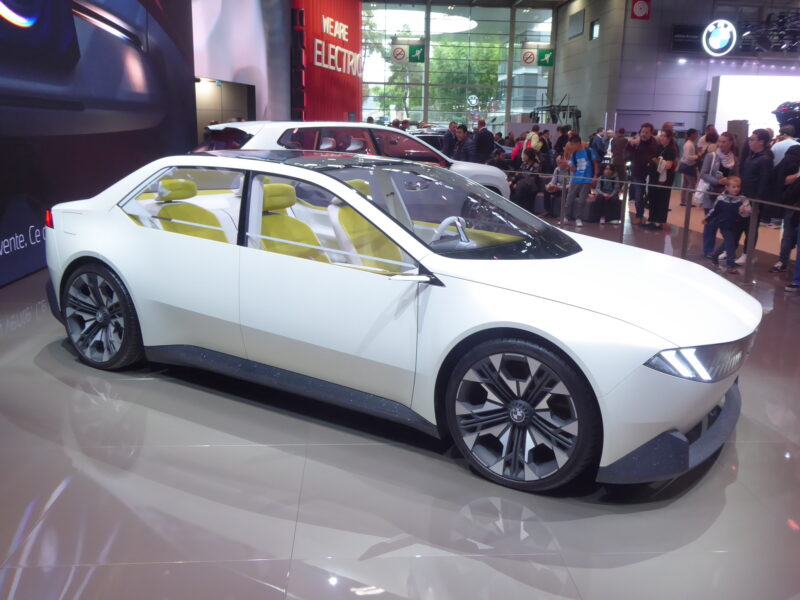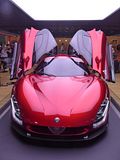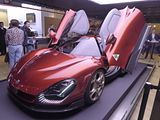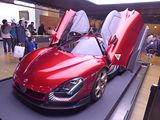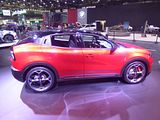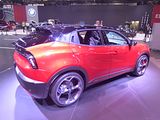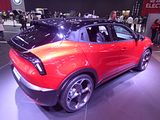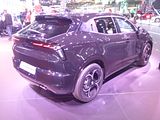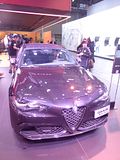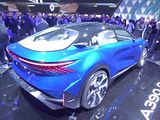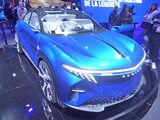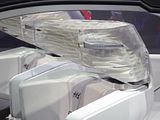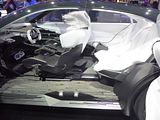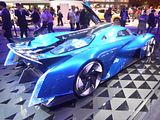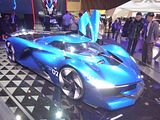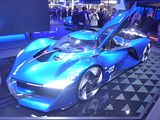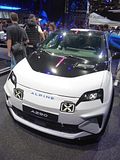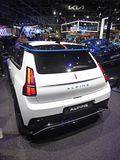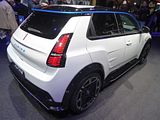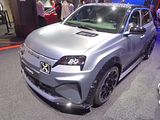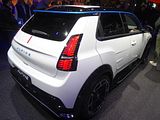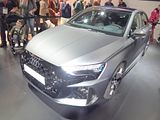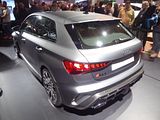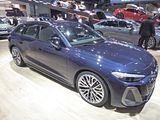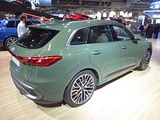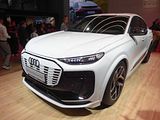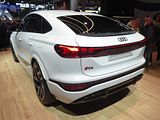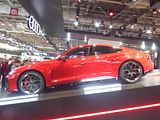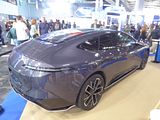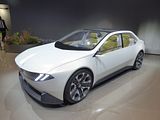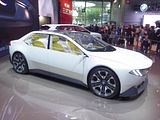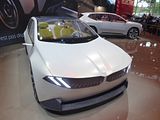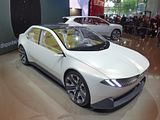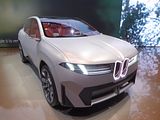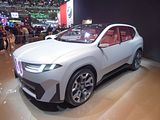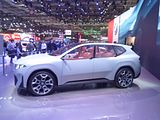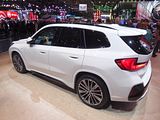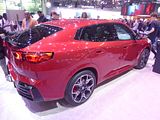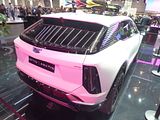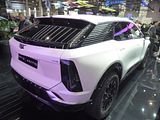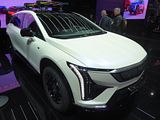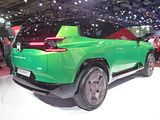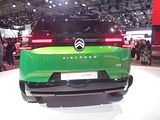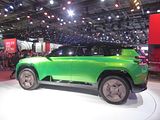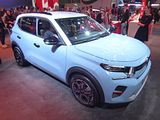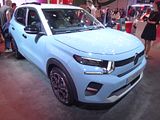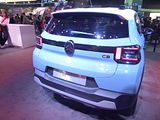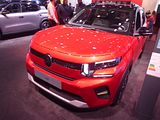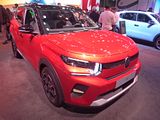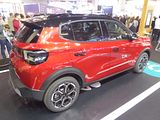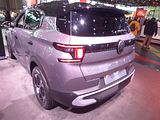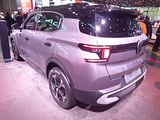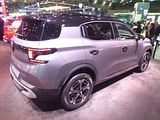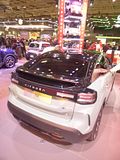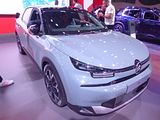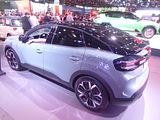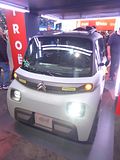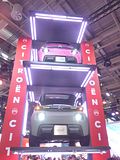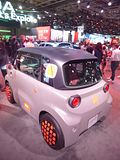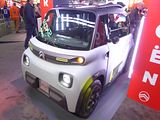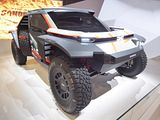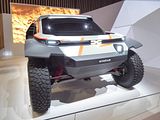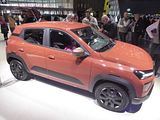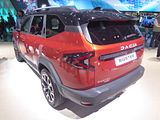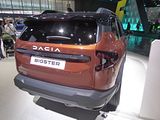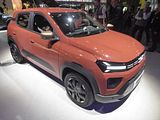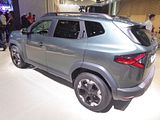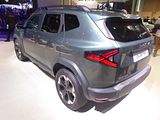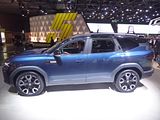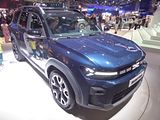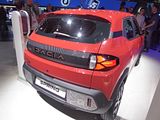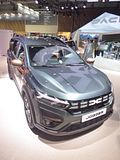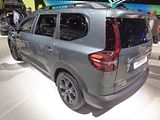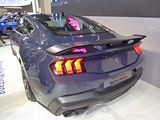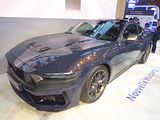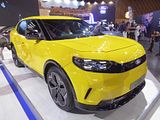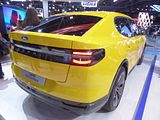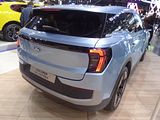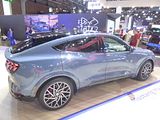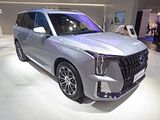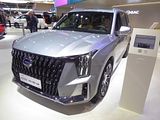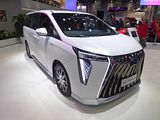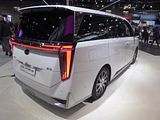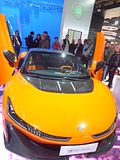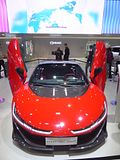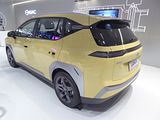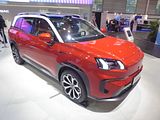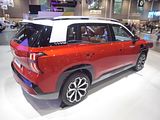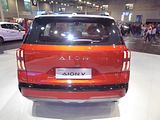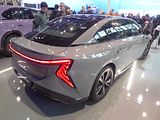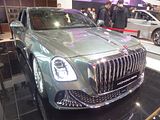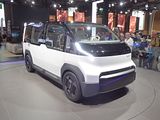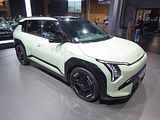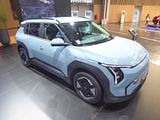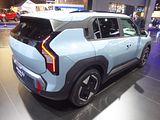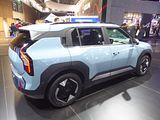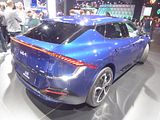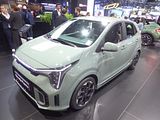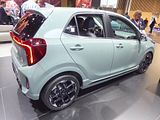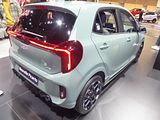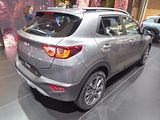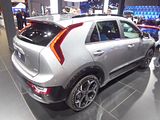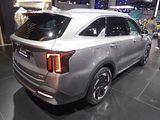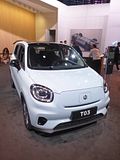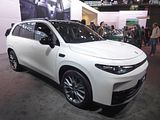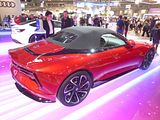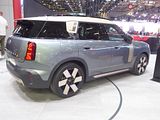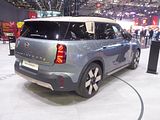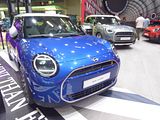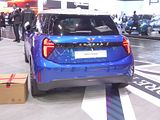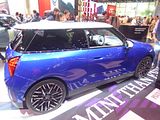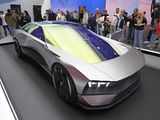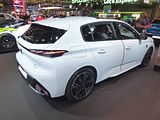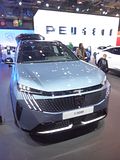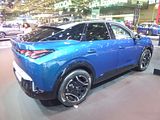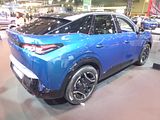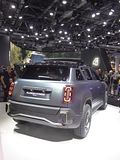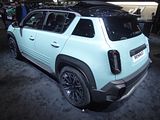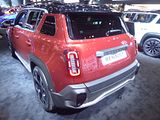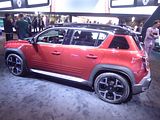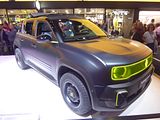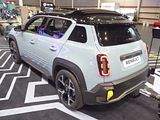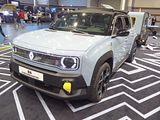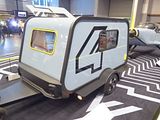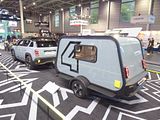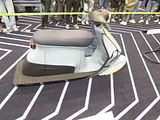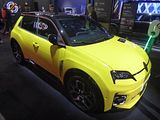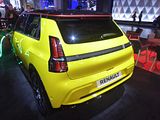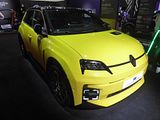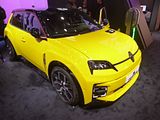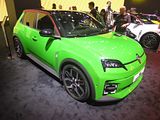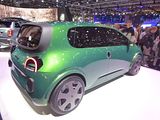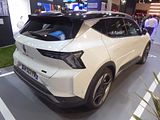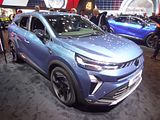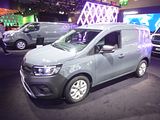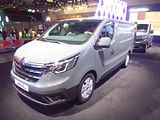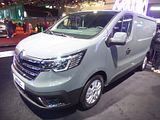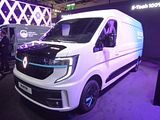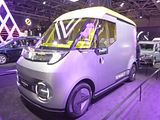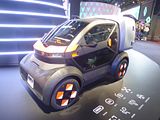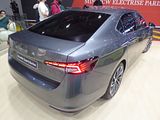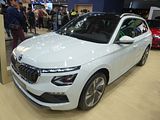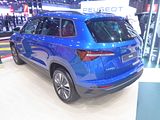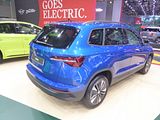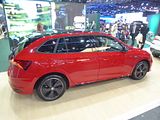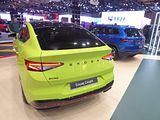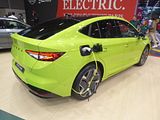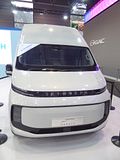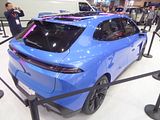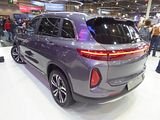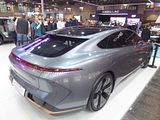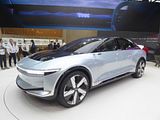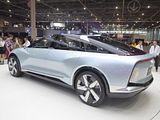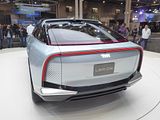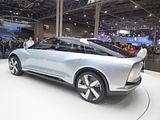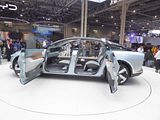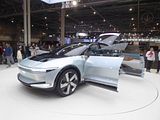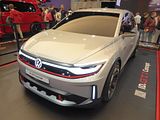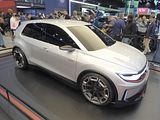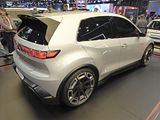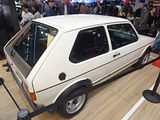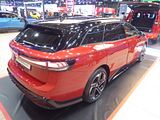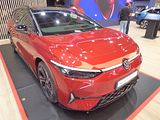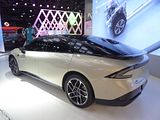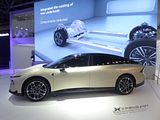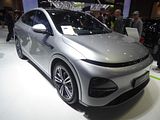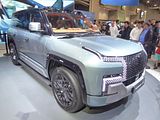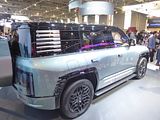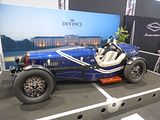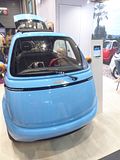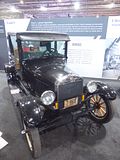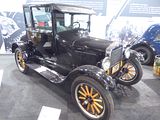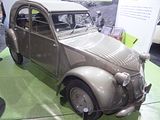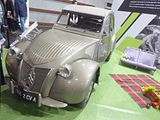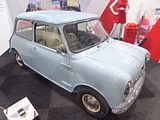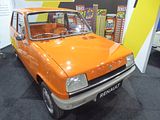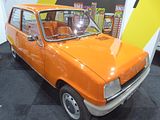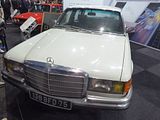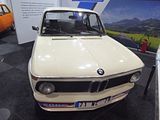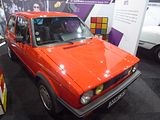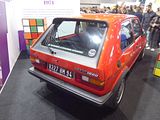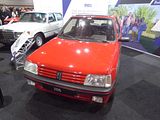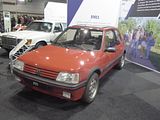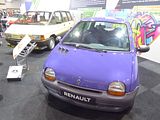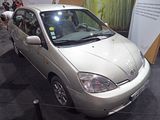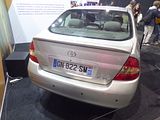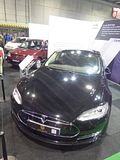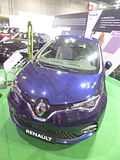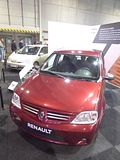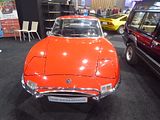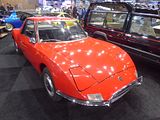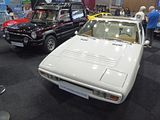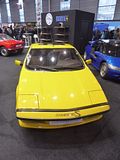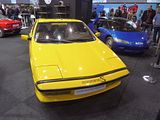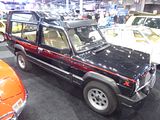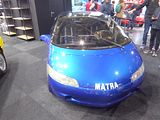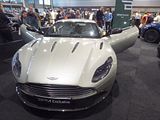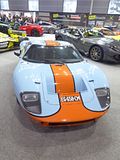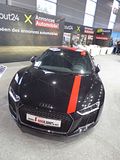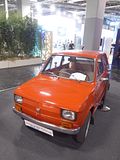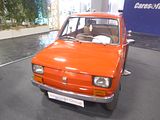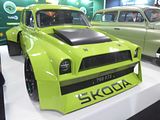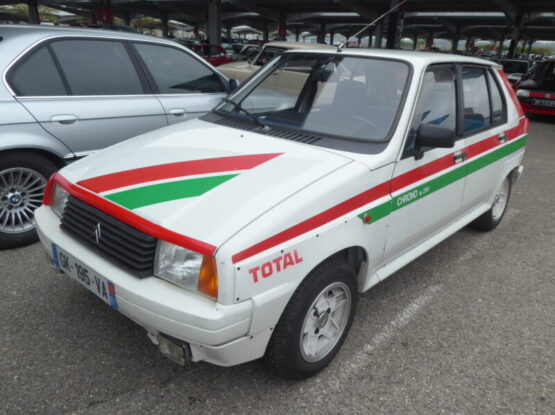The decline of the Motor Show has been both well documented and much lamented by all those who used to get all excited by the prospect of being able to see an entire market’s worth of offerings under one roof, and also to take in all the latest models, several of which had been kept under wraps until Show opening day. With increasing use being of social media and new ways of getting product news to an ever more savvy customer base, the traditional Motor Show seemed be losing out and even before Covid restrictions precluded all such events for more than a year, a growing number of manufacturers were choosing not to spend their marketing budgets on attending. Covid restrictions really did seem to be the final nail in the proverbial coffin for the Motor Show as we know it, and attempts to try to come up with a new formula that was more lifestyle and not just halls of cars generally seemed to miss the mark. Geneva announced events and then cancelled them, and when they finally held an event in early 2024, it was panned as being not worth bothering with. Detroit struggled even more, with a new date and format failing to hit the spot, too. So when the organisers of what had long been a biennial show, that held in Paris, started gearing up for a 2024 event, it was easy to ignore it. Indeed, that is what I was planning to do, but at the very last minute, the combination of quite a few European launches and some favourable publicity suggesting that as a mid-2020s Show goes, this was about as good as it gets, encouraged me, and a friend, to make a very last minute booking. It had to be a weekend, but we could fly in, spend a day at the Show and go home again relatively easily and relatively cheap, so we booked up.
As has been the case for many years, the Paris Show is held at the exhibition site at the Porte de Versailles, which comprises several halls, some interconnected, but all within easy reach of each other, so there is less walking involved than say at the NEC. The Show did not occupy the whole site. Indeed it never has, but it did completely fill four halls, which is more than was the case at the 2022 event. Several companies did decide to sit out the 2024 Paris Motor Show, including some big names like Cupra, Hyundai, Jeep, Lamborghini, Mercedes-Benz, Mitsubishi, Nissan, Polestar, Seat, Suzuki, Volvo, and Zeekr, but there was a whole hall dedicated to EVs, mostly from Chinese firms, many of which you’ve not heard of (but rest assured you soon will), some with cars you can buy now at least somewhere in Europe, and all with plans to penetrate what is still a huge automative market. In addition to the new cars, there were also displays of classic and super cars and a number of trade stands, so there was actually plenty to see. The show got stupidly busy, so getting photos was hard and even getting to see some of the cars was not easy, with the event not emptying out til pretty late in the day, but we managed to have a good look at everything that was on show, and the highlights are presented here.
NEW CARS
New cars were spread across three different halls, with expansive stands, lots of lighting and glitz to draw people in. Those present generally had a representative sample of their current ranges, though there were few concept and show cars of the sort that you used to see at events like this.
ALFA ROMEO
Let’s start with one of the real stars of the event, the gorgeous new 33 Stradale. One of just 33 custom-made examples, this is a supercar is available with either a 620 horsepower V6 twin-turbo engine or an electric 750 horsepower alternative. As a reincarnation of the 1960s 33 Stradale, this new model was designed in collaboration with the 33 enthusiast owners.
Of course the 33 Stradale is a halo model, but the car which really counts and which needs to sell in volume to help Alfa sales build up in the way we keep being promised they will, and then which they never do, is the Junior. It did not get off to the best of starts, as the car was launched back in April as the Milano, but an outcry including, allegedly, from Italian authorities, saw a quick renaming and within days it became the Junior. This is the brand’s highly anticipated subcompact SUV. Marking the brand’s first foray into the electric vehicle segment, the Junior becomes its smallest offering, joining the Giulia sedan and the larger Stelvio and Tonale crossovers in the Alfa Romeo lineup. The Milano presents Alfa’s spin on a familiar approach adopted by various Stellantis brands and models such as the Opel/Vauxhall Mokka, Fiat 600, Peugeot 2008, and Jeep Avenger, all of which utilize the same CMP2 platform. The sub-compact (B-segment in Europe) crossover will be available in a choice of two electric powertrains or a 48-volt mild-hybrid gasoline option. The Junior aims to be the sportiest model in its highly-competitive class, especially in the flagship Ellettrica Veloce trim. This top-of-the-line variant boasts a 237 hp electric motor and a sharper chassis setup for enhanced handling. Beyond the fully electric versions available at launch, the Junior will also be offered in Ibrida form. This variant features a mild-hybrid powertrain paired to an automatic gearbox, and the option for all-wheel drive. Alfa Romeo’s objective with the Junior was to captivate a new generation of consumers by embracing the latest design ethos of the Biscione brand. Though perhaps not as striking as its larger counterpart, the Tonale, the Milano boasts a visually compelling aesthetic characterized by intricate forms and bold detailing. The front end is rather busy-looking due to the elongated matrix LED headlights which are interconnected with slim intakes via dark trim. The new scudetto grille is partly covered in the fully electric version, signalling the start of a new era. The front bumper is inspired by the Quadrifoglio versions of the Giulia and Stelvio, featuring large intakes and an integrated splitter. The profile of the Junior is distinguished by its toned-up rear shoulders, large wheels, and greenhouse that seamlessly connects with the rear glass. While the latter boasts a steeper angle compared to traditional SUVs, it falls short of entering the coupe-SUV realm. Moving to the back, Alfa Romeo designers have chosen a “kamm tail” finish, reminiscent of the Giulia TZ. The black trim surrounding the taillights evokes elements of the 2025 Nissan Kicks, albeit with more “Italian” curves. Measuring 4,170 mm (164.2 inches) long, 1,780 mm (70.1 inches) wide, and 1,500 mm (59.1 inches) tall, the Alfa Romeo Junior perfectly fits within the European B-SUV segment. It surpasses the Jeep Avenger by 86 mm (3.4 inches) in length, matches the length of the Fiat 600, and falls 134 mm (5.3 inches) shorter than the Peugeot 2008. The interior, while less visually striking than the exterior, boasts a digital cockpit equipped with dual 10.25-inch displays. Alfa Romeo-specific touches, such as the distinctive graphics of the infotainment system and the Cannocchiale digital instrument cluster, try to set apart. The optional sports package includes Sabelt seats upholstered in Alcantara, while other trims offer Spiga vinyl and fabric upholstery paired with a leather steering wheel. Alfa Romeo brags about the 400 lt (14 cubic feet) of boot space in the Junior, complemented by a convenient cable storage compartment under the hood of the Ellettrica variant. In terms of safety features, the Milano offers Level 2 ADAS, akin to its competitors in the subcompact SUV segment. The Junior lineup will include the Ellettrica, Ellettrica Veloce, and Ibrida versions. The Milano Ellettrica Veloce stands as the flagship model, equipped with a single electric motor with 237 hp (240 PS / 177 kW), matching the upcoming Abarth 600e and Lancia Ypsilon HF. Power is delivered to the front axle, aided by a Torsen mechanical self-locking differential and a set of high-performance 20-inch tyres. The Veloce-specific chassis setup boasts “the most direct steering in the segment” with a ratio of 14.6. The sports suspension, lowered by 25 mm (1 inch) compared to other Milano models, is complemented by front and rear anti-roll bars. Additionally, the front brakes feature larger 380 mm (15 inches) discs and four-piston monobloc calipers. Alfa Romeo asserts that the top-tier Milano will deliver class-leading driving dynamics akin to the discontinued Giulietta and Mito hatchbacks. The entry-level Ellettrica produces a more restrained 154 hp (115 kW / 156 PS), with a 54 kWh lithium-ion battery offering 255 miles (410 km) of WLTP range and supporting up to 100 kW of charging speeds. These specs are identical to the army of similarly-sized EVs by nearly every Stellantis brand. The combustion-powered Junior Ibrida will arrive in 2025 featuring a turbocharged 1.2-liter gasoline engine with a not so Alfa Romeo-worthy, 134 hp (100 kW / 136 PS) mated to a 48-volt battery and a 28 hp (21 kW / 28 PS) electric motor integrated within the six-speed dual-clutch automatic gearbox. Power will be transmitted to the front or all four wheels, similar to the upcoming Jeep Avenger 4Xe. Unlike other Stellantis models, the Alfa Romeo Junior won’t be offered solely with an internal combustion engine (ICE), meaning it won’t come with a manual gearbox. The company also mentioned the availability of the Alfa DNA driving mode selector, but didn’t specify which Junior models will feature it. The Alfa Romeo Junior will be priced starting from under €30,000 ($32,200), with leasing options beginning at under €200 ($215) per month across all European markets. Moreover, special incentives will be available for owners of the MiTo and Giulietta looking to upgrade to the Junior. Alfa Romeo also unveiled the Junior Speciale trim, featuring 18-inch wheels and an extensive list of standard equipment, which will be available at launch. Orders for both the Ellettrica Speciale and Ibrida Speciale versions of the Junior commenced in April in Italy, with other European markets following soon after.
Also on the stand were examples of the Tonale and the long-running but still appealing Giulia.
ALPINE
An all-electric Alpine A110 is coming in a few years time, but for now we keep getting special edition versions of the current car. This is the A110 R Ultime, and it’s the most hardcore iteration of this sports car yet. The 1.8-litre engine is putting out 345hp, a 45hp increase over the standard R, and 0-60ph is dealt with in 3.8 seconds. It also has uprated brakes, stiffer suspension, a sports exhaust and a new gearbox to handle the extra power. Just 110 of these cars will ever be made, and they wear an eye-watering price tag of £220,000 – £130,000 more than a standard A110 R.
Previously, the top of the A110 range was the A110R. What started off as a single, and rather costly uplift over the “regular” A110 models has now become a more complicated set of offerings. By all accounts, the Alpine A110 R is really rather good (though I am personally not a fan of all the added carbon fibre). Rewarding on circuit, joyously deft on road, and a visual treat as well, it’s everything a flagship French sports car ought to be. But there’s a price to pay for that panache, and it’s very nearly £100,000 – £96,990 for the just-announced 2024 Model Year. Seemingly aware of the price (and usability) reservations buyers may have, at the end of 2023, Alpine launched a new A110 R – the Turini. It’s £5,000 cheaper than the regular R, which would pay for a whole lot of track days, and goes without the stunning carbon fibre wheels. They’re replaced by 18-inch GT Race Matte Black aluminium wheels; Alpine says the swap offers ‘greater versatility on the road’, and it will certainly make parallel parking less terrifying. But there’s a concern, surely, that reintroducing some of the unsprung mass back into the R might rob it of some of that magical delicacy found on the carbon rims. Let’s see. As far as can be told, everything else about the R package is unchanged for the Turini. A Le Mans still sits above the R in the 2024 A110 range, at a mighty £121,990. Speaking of specials, the A110 S Enstone Edition – Union Jack roof, carbon trim, special seats – continues into the new year as well, presumably as the planned 300-unit production run hasn’t yet all been spoken for. It costs £73,990. Seen here is the A110 R Turini.
Commercially more significant is the production version of this which Alpine was teasing. This is the marque’s first-ever crossover—the A390_β concept—though they refuse to use the “C” word, opting for the much cooler “sport fastback.” With dual motors and active torque vectoring, this five-seater promises to deliver the razor-sharp handling of the A110, all while doubling as a practical family car. It’s got scissor doors and an interior that screams sci-fi, though don’t get too excited as the production version will tone down the space-age vibes for daily driving. Built on the same platform as the Renault Megane E-Tech, the A390 is the second entry in Alpine’s “Dream Garage,” following the A290 hot hatch. The production version is set to drop next year, serving as a rival to the Porsche Macan EV.
Also a concept, but potential production is rather further away is this, the Alpine HY6 Alpenglow concept, an evolution of the brand’s hydrogen-powered supercar concept, originally unveiled in 2022. The new iteration swaps the original model’s four-cylinder engine for a more powerful V6 with 730 ponies, again running on hydrogen. The Alpenglow might be a rolling lab for new technologies, but Alpine hinted there is a chance it evolves into a production offering by 2028.
Alpine has committed to launching seven EVs by 2030, including an electric replacement for the A110, plus crossover SUVs. But first to arrive is the A290, a hot-hatch version of the new all-electric, retro-styled Renault 5 E-Tech. The fastest Renault 5 gets a 148 hp (110 kW / 150 PS) electric motor that drives the front wheels, and while the A290, which was unveiled today at the Le Mans 24 Hour race in France, sticks with the two-wheel drive layout, it ups the pony count considerably. Alpine’s version makes 217 hp (220 PS / 160 kW) and 221 lb-ft (300 Nm) in its most potent GT Performance form, which drops the zero to 62 mph (100 kmh) time from the 5 E-Tech’s 8 seconds to 6.4 seconds. A less powerful model, badged simply A290 GT, generates 178 hp (180 PS / 130 kW) and 210 lb-ft (285 Nm), and takes a second longer to reach 62 mph. The two-tier lineup puts the Alpine pair in direct competition with the new electric Mini Cooper E and Cooper SE, which make 181 hp (184 PS / 134 kW) and the same 217 hp as the Frenchies, and need 7.3 seconds and 6.7 seconds to achieve 62 mph. Adding to the impression of speed is a choice of two digital soundtracks that claim to be based on the natural harmonics of the A290’s electric motor. Though the extra grunt, and the temptation to use it, was always going to put a strain on the driving range, Alpine has stuck with the same 52 kWh battery offered in higher-spec 5 E-Techs for both A290 variants. And while that, plus some aluminium parts, has helped keep the curb weight down to 1,479 kg (3,260 lbs), it does mean the range suffers. Renault quotes a 249-mile (400 km) range for the 5, which drops to 236 miles (380 km) for the Alpines. That figure also matches what Mini claims for the Cooper SE, but the Cooper E gets a smaller battery and is only good for 190 miles (306 km). An unimpressive 100 kW DC charge rate means a 15-80 percent fill in the A290 takes 30 minutes. The stock 5 already looks fairly purposeful thanks to its chiselled lines and angular bulging fenders that tip a hat to the bonkers mid-engined Renault 5 Turbos of the early 1980s, but the A290’s track is 2.4 inches (60 mm wider), 19-inch wheels available in two different designs, filling the wheelarches. Both cars get Brembo four-pot brakes up front. Alpine has also applied its own styling details to A290, including X-shaped driving lights set into the grille, X-motifs in the headlights, a deep front bumper and three strakes ahead of the rear wheels. Like the Renault 5 it’s based on, the A290 is a five-door hatch, but it does a good job of looking like a two-door hatch by hiding the rear door handle in the corner of the window by the C-pillar. Inside, the basic dash architecture, including a 10.1-inch infotainment screen, is carried over from the Renault 5, but Alpine adds its own sports pedals and even a set of transmission selector buttons on the lower console, just like the ones you get in the A110 sports car. There’s a bespoke steering wheel too, whose ‘OV’ overtake button delivers the maximum 217 hp instantly, and which sounds like a pure gimmick since you can unleash the exact same thing with your right foot. More useful to our mind is the button to toggle between the A290’s four regen levels. The 178 hp A290 comes in either GT or GT Premium trim, the fancier one adding a black roof, Alpine Blue calipers, Nappa leather and premium hifi, while the 217 hp car offers red calipers and special Michelin Pilot Sport 5 tires in stock GT Performance trim, or can be ordered as a GTS, which bundles in the GT Premium goodies. Alpine hasn’t revealed full pricing but says the A290 will cost from €38,000 ($41k / £32k), which would make it more expensive than the Mini Cooper E/SE, which starts €34,000 in France ($37k / £ 29k). It’s available to order from this summer with left-hand drive deliveries scheduled for the end of the year. Right-hand drive markets won’t get their cars until early 2025, and, sadly, the US won’t get any at all. Of course no new-car reveal would be complete without the announcement of launch-edition model. In the A290’s case it’s the GTS Premiere Edition, which gets its own livery, extra equipment and a commemorative dashboard plaque, and is limited to 1,955 units, that number a reference to the year Alpine was founded.
AUDI
This was a very busy stand and there were a lot of new models to see here, as Audi has launched no fewer than four new ranges in the past few weeks, two of them replacing existing model families, and two of them adding still further to the extensive collection of models offered by the brand.
Audi has given its RS3 Sportback and Sedan models a nip and tuck for the 2025MY. Aside from the olfactory upgrades (more about that below), the RS3 gets a sharper look, a tweaked chassis, and a slightly louder exhaust. It’s faster in corners, and it’s still got that bonkers five-cylinder engine, which will bow out after nearly five decades in Audi’s stable (in one form or the other) when production ends for the two compact models and the RS Q3 SUV. Weirdly, it also gets a nose job, but not the one you’re thinking about. The German automaker has obsessed over the smell of its hot compact model, as it deployed a crack team of fragrance experts to ensure the RS3 smells as premium as its price tag. Nearly 200 interior components were dissected and analyzed in a quest to ensure it has an aroma that customers will appreciate… The RS3 Sedan recently obliterated the BMW M2’s Nürburgring lap record with a time of 7:33.123 minutes, setting a new benchmark for compact cars at the Green Hell. The pre-production prototype clocked in over 7 seconds faster than the 2021 RS3 and more than 5 seconds ahead of the previous compact segment record set by the BMW M2 Coupe. Both the RS3 Sedan and Sportback variants are powered by Audi’s 2.5-litre five-cylinder connected to a seven-speed dual-clutch automatic, still delivering 400 PS (394 hp) and 500Nm (369 lb-ft) of peak torque in European spec, still hitting 62 mph in 3.8 seconds with quattro, and still—on the top-tier Carbon Vorsprung trim—reaching a 180 mph (290 km/h) top speed. Audi’s refreshed RS3 Sedan and Sportback will hit European dealerships this month, with other markets following in due course.
Back in July, Audi introduced a new family of A5 and S5 models, featuring a range of mildly electrified powertrains. Unlike the outgoing two-door Coupe and Cabriolet with the same name, the new A5/S5 succeeds the ICE-powered A4/S4, offered in Sedan and Avant bodystyles. This strategic shift streamlines Audi’s naming convention, reserving odd numbers for gasoline models and even numbers for EVs. Alongside the A4 Sedan and Avant, the new model effectively displaces the A5 Sportback, as the A5 Sedan now features five doors including a practical tailgate. The adoption of the A5 moniker has ushered in more dynamic styling, characterized by sharper details and better proportions. The discontinued A4 faced criticism for its bland appearance in comparison to rivals like the BMW 3-Series and Mercedes-Benz C-Class, pushing Audi designers to up their game. Highlights include a more aggressive stance thanks to widened fenders, sleeker LED headlights flanking a slimmer grille, and oh-so-satisfyingly large bumper intakes that wouldn’t look out of place on a high-performance Audi Sport model. Plus, the taillights get a tech upgrade with fancy OLEDs. The new Audi A5 is the first production model to ride on the new PPC (Premium Platform Combustion) architecture, an updated version of the MLB Evo (Modular Longitudinal Matrix) platform. It boasts an increased wheelbase compared to its predecessor, stretching to 2,900 mm (114.2 inches). This translates to an additional 68 mm (2.7 inches) of space between the axles. While specific details on the overall length and width haven’t been revealed yet, we can expect them to be larger based on the extended wheelbase. Step inside the new A5, and you’re greeted by a thoroughly modern overhaul. Audi’s ditching the button clutter in favour of a clean, sophisticated design packed with standard features that push the A5 further into premium territory. Taking center stage is a curved panoramic display, a technological marvel that combines an 11.9-inch digital instrument cluster with a massive 14.5-inch touchscreen for the Audi MMI infotainment system. An enhanced head-up display keeps your eyes on the road, while an optional 10.9-inch screen for the front passenger adds a touch of extravagance (and maybe keeps them occupied on long journeys). Comfort takes priority too, with Audi promising more cabin space than before. The A5 avoids the all-electric shuffle, at least for now, and kicks things off with a tried-and-true 2.0-liter turbocharged TFSI four-cylinder. This workhorse gets a makeover, though, with a variable-geometry turbocharger (VTG) and a tweaked combustion process to squeeze out more efficiency. In Europe, power comes in two flavors: 148 hp (110 kW / 150 PS) for the front-wheel-drive version, or 201 hp (150 kW / 204 PS) for the quattro. The second option in Europe and other select markets is an updated 2.0-liter TDI turbodiesel, featuring the new 48-Volt MHEV plus system. This oil-burner benefits from a new 48-volt mild-hybrid system (MHEV plus) to keep emissions in check. The base engine delivers a healthy 201 hp (150 kW / 204 PS) and 400 Nm (295 lb-ft) of torque, but the electric motor throws in an extra 24 hp (18 kW / 24 PS) for a welcome boost. That translates to sprightlier acceleration and, of course, better fuel economy. The mild-hybrid TDI pairs with a dual-clutch automatic transmission, with the option of front-wheel drive or Audi’s legendary quattro all-wheel drive. For those craving serious thrills, the S5 ups the ante with an updated 3.0-liter V6 TFSI engine. This powerhouse gets the MHEV plus mild-hybrid treatment as well, packing a punch with 362 hp (270 kW / 367 PS) – that’s 13 hp more muscle than the S4 and S5 previously offered. All that grunt gets channelled to all four wheels via a slick-shifting S tronic dual-clutch automatic transmission, and Audi’s quattro sport differential with torque vectoring ensures you hug the corners with confidence. Audi claims the reworked suspension and steering setup result in “more precise” and “largely neutral handling”. For enthusiasts seeking more, the optional adaptive suspension purportedly provides a broader range from comfort to sportiness. The new Audi A5 and S5 family will be available to order in Europe later this month, ahead of the first deliveries in November. In Germany, the Audi A5 Sedan will be priced from €45,200 ($49,279). I have to say I was very disappointed in this car…. the outside is a mess, like all recent Audi models, and the interior seems to have thrown out the superlative quality you used to get with that gimmicky double screen set up that does not match and lots of cheap gloss black plastic. Give me my B8 generation car any day!
This is the latest and greatest Audi Q5, and it’s a big deal for the German marque. The Q5 has been a staple of its segment for over 15 years, so Audi has left no stone unturned in updating it, completely transforming the exterior design, and installing new and more economical petrol and diesel engines. Underpinning the new Q5 is Audi’s Premium Platform Combustion (PPC), and in the U.S., it will initially be sold in standard and SQ5 guises. Powering entry-level models is a 2.0-liter TFSI four-cylinder producing 268 hp and mated to a seven-speed S-tronic dual-clutch transmission, complete with Quattro All-Wheel Drive. The 2025 SQ5 rocks a 3.0-liter TFSI six-cylinder with 362 hp, the same seven-speed dual-clutch, and all-wheel drive. Things are a little different in Europe where the Q5 will be launched with three engine versions, all of which include a mild-hybrid system with a 1.7 kWh battery and an electric motor with 24 hp and 170 lb-ft (230 Nm) of torque. Found at the base of the range is a 2.0-liter TFSI with 201 hp, 251 lb-ft (340 Nm), and front-wheel drive, although all-wheel drive is an option. Audi is also launching the 2025 Q5 in Europe with a 2.0-liter TDI rated at 201 hp and 295 lb-ft (400 Nm). The European-spec SQ5 has the same 3.0-liter TFSI six-cylinder as the U.S. model, producing 362 hp and 406 lb-ft (550 Nm). Thanks to the new platform, as well as revised suspension and steering systems, Audi says the 2025 Q5 is noticeably more comfortable than the model it replaces. Standard models include Frequency Selective Dampers, while air suspension with adaptive damper controls is an option. SQ5 models ship with a sportier suspension setup. A new interior concept has been adopted for the latest-gen Q5, although it’s not a radical departure from other existing Audi models. A curved display houses the 11.9-inch digital instrument cluster and a 14.5-inch MMI infotainment display, while a 10.9-inch display is also available on the passenger side. A simple, flat-bottomed steering wheel is standard, but sadly, there are no physical controls, buttons, or switches for the HVAC, as they’re all housed within the screen. Interestingly, the infotainment system runs on the Android Automotive OS and includes access to apps, including YouTube. A head-up display is optional. Audi says the cabin of the new Q5 is more spacious than ever before. The rear seats also offer plenty of adjustment, including a tilt function. Other important features of the interior include a wireless and cooled phone charger, two USB-C ports up front, and two at the rear. Those at the rear can charge at up to 100 watts, enough for a laptop. Designing an SUV that looks sleek rather than cumbersome is no small feat, yet Audi has done just that. Thanks to clever styling touches, including the lovely curves and creases, the Q5 looks smaller than it actually is, and it’s nice to see a new car that isn’t dominated by sharp lines and dramatic angles. Among the key external elements include second-generation digital OLED taillights that can warn other traffic of accidents and breakdowns by displaying custom taillight graphics. Up front, you will find standard Matrix LED headlights with eight adjustable light signatures for the DRLs. Audi has not announced U.S. pricing for the new Q5. However, we know the standard model will start at €52,300 (~$57,800) while prices for the new SQ5 kick off from €82,900 (~$91,600).
Audi has now officially introduced the all-new 2025 A6 e-tron, marking a significant step forward in its electric vehicle lineup. Available in both Sportback and Avant body styles, the A6 e-tron takes direct aim at the Mercedes EQE and BMW i5. Unlike its predecessor, this generation will be exclusively electric, offering customers a pure electric driving experience. Following the imminent launch of the fully electric A6 e-tron, Audi is poised to revamp its traditional lineup. The current ICE-powered A6 is slated for a facelift and subsequent renaming to A7, aligning with the automaker’s new strategy of designating even numbers for electric models. The production A6 e-tron closely mirrors its 2021 (Sportback) and 2022 (Avant) concept predecessors. Subtle refinements include slightly adjusted split headlights, a more prominent black grille surround, traditional door handles, and broadened full-width taillights. Audi states that the high-tech Matrix LEDs at the front and the second-gen OLEDs at the back offer eight different digital lightning signatures, and can be combined with an illuminated emblem on the tailgate. Unfortunately, due to US regulations, some high-tech features such as the adaptive matrix LED headlights, the active digital light signatures, the car-to-X communication, and the virtual mirrors, won’t make it across the Atlantic. Audi has prioritized aerodynamics in the development of the A6 e-tron, conducting over 1,300 simulations and extensive wind tunnel testing. The result is the most aerodynamic Audi ever made, and the most aerodynamic vehicle on offer by the VW Group. The Sportback variant boasts a drag coefficient of 0.21 Cd, edging out its direct rivals but falling slightly short of the larger Mercedes-Benz EQS’s 0.20 Cd. Furthermore, the A6 Avant e-tron claims the title of most aerodynamic estate in its class with a drag coefficient of 0.24 Cd. The dashboard and center console are largely carried over from the Audi Q6 e-tron. Dominating the dashboard is a triple-screen setup comprising a 11.9-inch digital instrument cluster, a 14.5-inch infotainment display, and a 10.9-inch passenger touchscreen. Complementing this digital extravaganza are two additional screens serving as virtual mirrors, and a generous suite of ADAS systems. Among the optional features there is a panoramic glass roof that turns opaque at the touch of a button, a four-zone automatic AC system with fragrance dispenser and ionizer, plus a Bang & Olufsen Premium Sound System with 20 speakers and 830 watts. The Audi A6 e-tron is based on the PPE architecture, just like the Q6 e-tron and the Porsche Macan EV. At launch, the lineup includes three powertrains, with more RWD and AWD options following at a later date, depending on the market. The base Audi A6 e-tron Performance is rear-wheel driven, propelled by a single electric motor generating 362 hp (270 kW / 367 PS). For those demanding more, Audi offers the A6 e-tron quattro, equipped with a dual-motor setup and all-wheel drive, boosting output to 422 hp (315 kW / 428 PS). Audi has also unveiled the performance-oriented S6 e-tron, set for global release. The rear-biased AWD system produces a combined 496 hp (370 kW / 503 PS), which increases to 543 hp (405 kW / 551 PS) when launch control is activated. The 0-100 km/h (0-62 mph) acceleration is completed in 3.7 seconds, while top speed is electronically limited at 240 km/h (149 mph). Spy shots confirm Audi Sport is already developing an RS6 e-tron flagship. Expect a more aggressive design and significantly boosted performance compared to the S6 e-tron. Both the A6 e-tron and S6 e-tron feature a floor-mounted battery pack with a capacity of 100 kWh (94.4 kWh net), while the 800V architecture supports 270 kW DC charging. Range figures are impressive, with over 720-750 km (447-466 miles) for the A6 e-tron, and over 640-670 km (398-416 miles) for the S6 e-tron depending on the bodystyle. Audi also confirmed that a smaller 83 kWh battery option will be offered in the future, hinting at more affordable variants. Regarding the chassis setup, the optional adaptive air suspension offers four ride height levels. When efficiency mode is activated from the Audi drive select menu, ground clearance is automatically reduced by 20 mm (0.8 inches) at higher speeds to enhance aerodynamics. The base A6 e-tron comes with 19-inch aero-optimized wheels, while the S line and S6 e-tron feature 20-inch alloys, with an option for 21-inch wheels. The Audi A6 e-tron will be available to order in Europe starting September 2024. Prices in Germany begin at €75,600 ($81,928) for the A6 Sportback e-tron Performance, and €99,500 ($107,829) for the S6 Sportback e-tron. In both cases, the Avant body style adds a premium of €1,650 ($1,788). Pricing for the US lineup, including the A6 e-tron (RWD), A6 e-tron quattro (AWD), and S6 e-tron (AWD), will be announced at a later date.
The Q6 E-Tron lineup expands with the addition of the sleeker Sportback variant. While it shares many features with the standard model, including sculpted fenders and LED taillights, the Sportback introduces a reworked greenhouse and a ducktail spoiler for a more streamlined look. Powertrain options match those of the Q6 E-Tron, with both single and dual-motor setups. Audi has also confirmed that the Sportback retains the Q6 E-Tron’s five-star Euro NCAP safety rating.
The Audi e-tron GT and RS e-tron GT, on sale since 2021, are both very powerful, extremely comfortable, and absolutely gorgeous. Now, the German marque has updated the e-tron GT range for the 2025 model year, and in addition to updating the base model and the RS, there’s also a new RS Performance flagship. Underpinning the new e-tron GT family is a 97 kWh battery pack, which is 19.8 lbs (9 kg) lighter than the 84 kWh pack of the outgoing model. The regenerative braking system has also been improved, increasing from 290 kW to 400 kW and adjustable through paddle shifters behind the steering wheel. The new model can travel up to 378 miles (609 km) on a single charge under ideal conditions. Peak charging speeds have also been lifted from 270 kW to 320 kW, meaning the battery can charge from 10-80% in just 18 minutes, while a 10-minute top-up can add 174 miles (280 km) of range. Improvements made to the battery also mean it can maintain a charge speed of over 280 kW for far longer than the old model. The battery can also be cooled or warmed for quick charging. Significant changes have also been made to the electric motors of the e-tron GT. The base model, now known as the S e-tron GT, features a pair of motors that combine to produce 670 hp (500 kW), more than the old RS e-tron GT. Meanwhile, power for the 2025 RS e-tron GT has been upped to 845 hp (630 kW) and the new flagship RS e-tron GT Performance delivers 912 hp (680 kW), making it the most powerful Audi ever. With this extra power comes extra speed. The 2025 S e-tron GT demolishes the sprint to 62 mph (100 km/h) in just 3.4 seconds, just 0.1 seconds behind the outgoing RS version. Meanwhile, the new RS e-tron GT can hit 62 mph in 2.8 seconds, while the RS e-tron GT Performance does the same sprint in 2.5 seconds. The S e-tron GT will continue to pull through to 152 mph (245 km/h) while the RS models top out at 155 mph (250 km/h). Audi has also fitted new brakes. The S e-tron GT comes standard with steel discs and the RS models have tungsten carbide-coated discs as standard. All 2025 models can be optioned with carbon-fiber-ceramic discs and 10-piston front calipers. Significant upgrades have been made to the standard air suspension and the optional active suspension. The new setup promises to keep the car “nearly horizontal during dynamic braking, steering, and acceleration,” and features adjustable ride height. All-wheel steering is also an option. Several small changes have been made to the cabin of the 2025 e-tron GT family. These include new seats, a different steering wheel, and an optional panoramic glass roof that can turn opaque with the touch of a button. The Audi virtual cockpit has also been updated and there’s a new mix of materials, including wooden inlays, Dinamica microfiber, and optional 18-way adjustable seats. European prices for the new S e-tron GT start at €126,000 (~$135,000) and increase to €147,500 (~$158,000) for the RS e-tron GT and €160,500 (~$172,000) for the RS e-tron GT Performance.
Also on the stand was Audi’s latest LMP car, as seen at the Le Mans 24 Hours race.
AVATR
The Avatr 12 (Chinese: 阿维塔12; pinyin: Ā wéi tǎ 12; pronounced “one two” or “yao er”, not “twelve”) is an electric executive car produced by Avatr Technology, a joint venture between Changan Automobile and lithium-ion battery provider CATL. It is the second vehicle under the Avatr brand. In July 2023, Avatr Technology presented the second model in its range as part of the expansion of the range that so far consisted of only the 11. The 12 took the form of a flagship executive car combining the features of a sedan and a fastback in its proportions. Like the 11, the styling design was created by former BMW designer Nader Faghihzadeh. The characteristic visual features of the 11 with massive proportions were transferred to a more slender silhouette, which retained round edges, double lighting with a “C” motif and narrow strips of rear lamps. The door handles were hidden, and the small rear window was integrated with the smoothly sloping glass of the low roof. The edge of the trunk lid is topped with an optionally hinged spoiler, which opens together with the window, as in liftbacks. The car is also equipped with an optional camera system replacing traditional side mirrors. The wheels come in two sizes: 20 or 21 inches. The interior features a steering wheel with an oval shape, and the central 15.6-inch touchscreen of the multimedia system dominates the central console. One large horizontal screen across the entire width of the cockpit. On 12 August 2024, Avatr showcased a limited edition of the 12 called the Avatr 012 and opened bookings the same day, after first teasing the special edition earlier that year on 20 May. The model is codesigned by Avatr head designer Nader Faghihzadeh and Kim Jones, who was an artistic director at Dior and Fendi at the time. The exterior features custom ‘liquid silver’ paint, modified headlights, and 21-inch mirror-finished forged wheels. The interior uses the four-seater version with four-zone climate control, and features two-tone white vegetable-tanned Nappa leather and tan Alcantara upholstery, a geometric star design on the panoramic sunroof, special edition logos embossed in the headrests, and custom logo splash screen in the infotainment system. The steering wheel and B-pillar can have personalized engravings. It uses a dual-motor 402 kW (539 hp; 547 PS) Huawei DriveONE powertrain paired with a 93.4 kWh CATL-supplied battery capable of 5C charging. It has a CLTC range rating of 650 kilometres (404 mi), 0–100 km/h (62 mph) acceleration time of 3.8 seconds, a top speed of 220 km/h (137 mph), and it can charge from 30–80% in 10 minutes. Production is limited to 700 units globally, and the vehicle comes with a complimentary Dior tote bag. and the vehicle launched on 25 March 2025 at a significantly higher price of 700,000 yuan. The 12 was created for the domestic Chinese market, where its official debut took place in August 2023, and in early September, during IAA Mobility 2023 in Munich, the car was also presented to the European public. The beginning of deliveries of the first units to buyers was scheduled for December of the same year, positioning the model as a premium product. Sales began in China on 10 November 2023.
BMW
Star billing was given here to two concepts which based on the Neue Klasse concept that BMW announced a while back. We are told that these will bring in a completely new look (which, given BMW styling of recent years, many will find welcome) as well as being engineered on a brand new platform designed for electric vehicles. The BMW Vision New Class is a sporty electric sedan for the premium mid-range, comparable to the original Neu Klasse. Back then, the 1500 series premium executive cars accomplished nothing less than building up the market for the arrival of its iconic 3 and 5 series. The new production car will have enormous shoes to fill.
The BMW Vision New Class X brings the technology of the future generation of vehicles to the critical premium mid-size SUV segment that BMW calls Sports Activity Vehicle, essentially laying the groundwork for a new electric X series. We should see the first product in this family in about a year’s time with the launch of the new iX3.
The ICE powered X3 was debuting in a new fourth generation here right now. And what an ugly thing it is. This really does look like the XM for those who cannot afford an XM. Blocky buily and vulgar in equal measure, it really does exemplify what is wrong with BMW design at present.
And if you want further proof, then look at the latest X2 or the bulbous iX.
By comparison, the i4 is almost good-looking. Almost!
The BMW M Hybrid V8 is he Bavarian brands entry in the hypercar class of the World Touring Car Championship. The sports prototype racing car was designed by BMW M and built at Dallara, and debuted in the 24 Hours of Daytona of 2023. The BMW M Hybrid V8 race car was entered the 2024 WEC, and the rather fitting art car livery was unveiled before the Le Mans race. The pattern was designed by Ethiopian American contemporary visual artist Julie Mehretu. For the design of the 20th BMW Art Car, she transformed her painting “Everywhen” into a three-dimensional imagery. Le Mans Art Cars have a long history with BMW, and this car fills some really big shoes.
BYD
BYD’s rapid European push continues with the Sealion 7, an all-electric SUV loosely aimed at the Tesla Model Y. It brings dual electric motors and BYD’s Blade battery tech to the table. With 0-100 km/h in 4.5 seconds and a range of 342 miles, it’s not short on performance. But while it may look sleek and aggressive, will it have the bite to dethrone Tesla? UK deliveries start in October, with prices hovering around £45,000.
CADILLAC
Having sold their European business to PSA (now Stellantis) back in 2017, GM is now talking about trying again to sell cars in Europe. One of the vehicles they think might prove popular is the Cadillac Optiq. It has not got off to the test of starts in the US with journalists asking why on earth would you spend an estimated $54,000 to get a Cadillac Optiq when the Tesla Model Y Performance is available now for $51,490 before incentives? That’s an uncomfortable question, but one we’re left asking as the Optiq is likely facing an uphill battle. The problem isn’t just Tesla as Cadillac’s own Lyriq begins at $58,590 and that isn’t much more than the brand’s entry-level EV. So what does the US-spec Optiq have to offer? A standard dual-motor all-wheel drive system producing an estimated 300 hp (224 kW / 304 PS) and 354 lb-ft (479 Nm) of torque. The model also rides on the Ultium platform and features an 85 kWh battery pack, which promises to deliver around 300 miles (483 km) of range. Cadillac was coy on additional details, but said the model can get up to 79 miles (127 km) of range in about 10 minutes using a DC fast charger. Cadillac didn’t have much else to say about the crossover, but it features a Lyriq-like design with a black crystal grille, a choreographed lighting sequence, and a fixed glass roof. The model also sports flush-mounted door handles and acoustic laminated rear quarter glass with a unique design. In terms of size, the Optiq measures 190 inches (4,820 mm) long, 84 inches (2,126 mm) wide, and 65 inches (1,644 mm) tall with a wheelbase that spans 116 inches (2,954 mm). Cadillac seems to have strangely rounded off those numbers, but the company claimed the wheelbase is 6 inches (152 mm) shorter than on the Lyriq. However, if the Chinese-spec model is any indication, the actual difference might be a more modest 5.5 inches (140 mm). Questionable numbers aside, the Optiq has a Lyriq-inspired interior with a 33-inch display that features Google built-in. The model also has a 19-speaker AKG audio system as well as best-in-class “cargo capacity and second-row spaciousness.” We can also see metallic accents as well as a mix of leather and fabric upholstery. The model comes standard with Super Cruise as well as an assortment of other driver assistance systems including adaptive cruise control, forward collision alert, and blind zone steering assist. The 2025 Optiq will go into production this fall and be offered in Luxury and Sport guise. We can expect to learn more about the US-spec model closer to launch, but the crossover will be sold in Europe as well as China, where it debuted exactly one month ago. The Arctiq version seen here is a demo car showcasing a dedicated white paint and new 18-inch wheels.
CITROEN
Citroen’s C5 Aircross Concept offers a preview of next year’s production model, the latest evolution of its compact SUV. It’s a sleek, futuristic take on the C5 Aircross, with the brand’s funky styling dialed up to eleven. Expect a focus on comfort and practicality. The concept hints at electrification, with full EV and hybrid options likely on the table. Inside, there’s a minimalist yet functional design, clearly targeting families who need space without sacrificing style. It’s Citroen’s way of proving practicality doesn’t have to mean boring.
The current C5 Aircross was also on display.
Citroen has now unveiled the ICE versions of its new C3 supermini, available with both standard and mild hybrid powertrains, six months after the debut of the otherwise identical, fully electric e-C3. The fourth-generation of the C3 inherits stronger crossover styling cues and emphasizes affordability, with prices starting from €14,990 ($16,275), making it cheaper than its predecessor. The entry-level version of the Citroen C3 is equipped with a non-electrified turbocharged 1.2-liter three-cylinder gasoline engine that produces 100 hp (75 kW / 102 PS). Power is exclusively transmitted to the front wheels through a six-speed manual gearbox. The more efficient “Hybrid 100” version utilizes the same gasoline engine as its base, albeit enhanced with a 48-volt lithium-ion battery and an electric motor integrated within the six-speed dual-clutch automatic gearbox. The electric motor alone produces 28 hp (21 kW / 28 PS), although only 12 hp (9 kW / 12 PS) of those can be utilized for acceleration when required. It’s worth noting that the same setup can be found on the Jeep Avenger Hybrid. Citroen claims that the mild-hybrid version can run on electric mode for up to 50 percent of journeys in urban environments, while reducing emissions and fuel consumption by nearly 10 percent compared to the non-electrified equivalent. From the outside, it’s hard to tell the C3 apart from its e-C3 sibling, as the models share the same bodywork. The only difference is the absence of the “e” emblem on the profile, and the C3 badge on the tailgate. The model is available in two trim levels as part of Citroen’s efforts to streamline its range. The minimalist dashboard showcases a 10.25-inch infotainment display on the flagship “Max” trim, while buyers of the entry-level “You” will have to settle for a smartphone holder. The new Citroen Head Up Display compensates for the absence of a traditional instrument cluster and comes standard in both trims. Additionally, there are plenty of storage compartments that enhance the practicality credentials of the supermini. Equipment options include automatic A/C, wireless charging, and smartphone mirroring, while ADAS features are primarily limited to the essentials. Despite measuring 4,015 mm (158.1 inches) long, the new Citroen C3 is claimed to offer more interior space and easier ingress compared to the previous generation. This is largely attributed to the higher ground clearance of 197 mm (7.8 inches) and the taller body. Additionally, the boot has grown by 10 liters (0.35 cubic feet) to a more generous 310 liters (10.9 cubic feet). Similar to its predecessor, the new C3 prioritizes comfort, with plush seats that utilize a generous amount of foam. Additionally, the model comes standard with Citroen Advanced Comfort suspension, featuring progressive hydraulic cushions to efficiently absorb bumps. It’s worth noting that the EU-spec C3 is based on the new Smart Car architecture, featuring region-specific modifications compared to the mechanically-related New C3 that is on sale in India and South America. Deliveries of the 2024 Citroen C3 are expected to commence in Europe this summer. In France, pricing starts from €14,990 ($16,275) for the C3 You with the non-electrified 1.2-liter engine and a manual gearbox. For comparison, the outgoing C3 which was originally introduced in 2016 and received a facelift in 2020, is currently priced from €16,590 ($18,014) in the same market. As for the fully electric 2024 Citroen e-C3, it starts from €23,300 ($25,301) although a more affordable version will follow in 2025 with a €19,990 ($21,708) price tag. The primary rival of the Citroen C3 is the Dacia Sandero Stepway, which is the only other crossover-style contender in the supermini segment. Another potential threat is the closely-related next-gen Fiat Panda, set to debut in summer 2024, likely mirroring the specs of its French sibling.
As indicated by the teasers and the speculative renderings, the C3 Aircross draws inspiration from the 2022 Citroen Oli concept, presenting a beefier rendition of the e-C3 supermini. Notable design features include Citroen’s fresh oval-shaped double-chevron badge, a prominent front fascia devoid of a traditional grille, contemporary LED headlights, and substantial cladding resembling oversized skid plates encircling the bumper intakes. The side profile and greenhouse are expected to be identical to those of the New C3 Aircross, with the goal of reducing production and development costs. Consequently, the new generation is likely to grow in size, potentially aligning with the 4.32 meters (170.1 inches) length of its South American counterpart, which surpasses its predecessor’s length by 170 mm (6.7 inches). Additionally, distinctive futuristic aerodynamic wheels and revamped LED taillights will serve to distinguish the two models, rendering the C3 Aircross more in line with European preferences. The roomy and practical interior is poised to be a key selling feature of the 2024 Citroen C3 Aircross. Despite belonging to the sub-compact SUV (B-SUV) category, Citroen has affirmed that the model will offer a spacious three-row, 7-seater configuration. It’s worth noting that the only other option in this price range with a similar number of seats is the Dacia Jogger. The larger footprint compared to the outgoing model will translate to more space for passengers and their luggage, bringing the C3 Aircross closer to the larger C5 Aircross. Citroen’s reputation for emphasizing comfort over sportiness suggests that the sub-compact SUV will likely get the plushy Advanced Comfort seats and a brand-specific suspension setup giving it a pillow-y ride.
Citroen has given its compact-sized 2025 C4 and C4 X a facelift, but don’t expect any drastic changes. The bolder front end, with sleek new headlights and a redesigned grille, feels more aggressive—likely a move to help them stand out in a saturated market. Inside, the updates stay subtle with a new 10-inch display and upgraded tech. Powertrain options are mostly the same, though an electric e-C4 variant is available for those ready to ditch petrol. If you weren’t already convinced, this refresh probably won’t change your mind.
Citroen’s quirky little electric quadricycle, the Ami, just got a facelift for 2025. With a refreshed front end and headlights that look like they’ve been given a set of eyelids, the Ami continues to embrace its oddball personality. Citroen also threw in a nod to its heritage, with fake 2CV-inspired gills on the front and rear fenders. Joining it in Paris is the Buggy Vision concept—think of it as the Ami’s beach-bum cousin, sporting rugged off-road tyres, no doors, and a roof-mounted LED bar. While the mechanicals remain unchanged (still rocking 8 hp), Citroen is clearly leaning into into playful design, and it works.
DACIA
The Sandrider is a prototype to compete in the Dakar Rally and the World Rally-Raid Championship (W2RC) in 2025. The car resembles their Manifesto show car, a concept car that was never intended for production in any way but is used as a testing ground on wheels for new ideas. Among them, the most spartan (or shall we say Dacian?) was the Romanian brand’s implementation of the BYOD principle (that you have to use your phone as a dashboard screen).
Recently on sale is the new generation Duster and there were several of them on the stand here.
The Dacia Bigster marks the Romanian brand’s foray into the compact SUV segment, aiming to deliver a blend of practicality and rugged styling at an affordable price point. Based on the 2021 concept, the production model is a longer version of the Dacia Duster, sharing its CMF-B platform and powertrain options. The Bigster measures 4.57 m (179.9 inches) in length, 1.81 m (71.3 inches) in width, and 1.71 m (67.3 inches) in height—making it about 230 mm (9 inches) longer than the Duster and the longest model Dacia has produced to date.
The Spring is an all-electric city car which goes on sale in the UK in a few weeks time. With a low price, it could do well, like all other Dacia models seem to do.
Completing the stand were the existing models including the recently released Jogger.
DONGFENG
The M-Hero 917 (Chinese: 猛士917; pinyin: Mengshi 917) is a mid-sized luxury SUV manufactured by the Dongfeng Motor Corporation under the M-Hero brand. The 917, which is the first vehicle under the M-Hero brand, was introduced in August 2022 and launched the following year. It is also part of the Dongfeng Mengshi family of off-road vehicles. The 917 was previewed by the Mengshi M-Terrain EV SUV concept car. The prototype was introduced in August 2022 during the launch of the independent M-Hero brand, with the production 917 being unveiled in January 2023. Production started on 5 April and the vehicle was launched for the Chinese market on 25 August 2023. The 917 comes in two versions, the BEV and the EREV. The BEV version is equipped four electric motors with a battery capacity of 142.7 kWh and its maximum range reached up to 505 km (314 mi). The four motors drive each of four wheels which produce 197 kW (264 hp; 268 PS) respectively, giving a total power of 797 kW (1,069 hp; 1,084 PS). The EREV version has an 1.5L inline-four turbocharged petrol engine as a generator which has 145 kW (194 hp; 197 PS), powering three motors (one on front axle and two on rear axle), giving 600 kW (805 hp; 816 PS) of power output combined. The battery capacity of EREV version is 66 kWh which enable the vehicle to drive 200 km (120 mi) on pure electric range.
FORD
It is two years since Ford launched the seventh generation Mustang, and the car is now, finally appearing in Europe. There was one example on the stand and it was popular with show go-ers who all wanted a closer look.
When Ford announced that they were going to dip into their archive of classic badges to help generate a buzz around a new EV, and they had selected the Capri name, there was far from universal approbation. Indeed most people expressed strong disapproval, which can’t have given this car an easy start in life. Capri EV is an electric coupe-SUV based on Europe’s new compact Explorer. Both cars use the same VW MEB platform found under EVs like the ID.4 and ID.5 and share a 2,770 mm (109 inch) wheelbase. But whereas the boxy Explorer appeals to families looking for practicality, the sportier Capri sacrifices some space with a sloping fastback tail. VW did something similar to turn the ID.4 into the ID.5, but Ford’s attempt to coupe-ify the Explorer didn’t stop with a sloping rear hatch. To justify the Capri badge Ford’s design team threw in some design cues inspired by the 1969-86 Capri coupe, which was Ford’s attempt to replicate the success of the Mustang for a European audience. So there’s a black band across the nose mimicking the look of the original’s grille, and the lights at each corner have DRLs arranged in pairs to evoke the Mk1 Capri’s quad-headlight setup. Other retro-inspired details include the subtle fender peaks and oval rear side window, a flicked-up tail that tips a hat to the RS3100’s ducktail spoiler and rear DRLs that evoke memories of the Mk3 Capri’s taillights. But even if potential buyers don’t remember the Capri – and there’s a good chance they won’t, seeing as it was axed almost 40 years ago – the design still works. It kind of looks like a Polestar 2 after two rounds of P90X and some leg-lengthening surgery. Inside, it’s mostly carried over from the Explorer, down to the 14.6-inch portrait infotainment screen and secret, lockable stash hole behind it. But there is one fun retro detail: the bottom spoke of the steering wheel riffs on the look of classic sports steering wheels with their drilled metal spokes, like the one fitted to some of the Capri RS2600 homologation specials. But the only similarity between the new Capri and old under the skin is that the base version of the SUV is rear-wheel drive. Thankfully it doesn’t have a live rear axle, instead getting a modern multi-link setup, and even the entry-level single-motor Capri’s 282 hp (286 PS / 210 kW) output is almost double what the most powerful naturally-aspirated production V6 Capri could deliver. None of the vintage coupes could touch this one’s 6.4-second zero to 62 mph (100 kmh) time, either. Drivers looking for even more muscle, or just all-wheel-drive security, have the option of upgrading to the 335 hp (340 PS / 250 kW) dual-motor Capri, though its 5.3-second 0-62 mph capability means giving up on some driving range miles. The bi-motor car gets a 79 kWh battery instead of the base version’s 77 kWh pack, but its curb weight is up, too, from 2,098 kg (4,625 lbs) to 2,174 kg (4,793 lbs) in its lightest form. Ford says you’ll get up to 390 miles (627 km) out of a 282 hp model but only 368 miles (592 km) from the 335 hp, twin-motor EV. The dually does charge slightly faster because it can accept 185 kW instead of the base model’s 135 kW, though two minutes (10- 80 percent in 26 versus 28 minutes) is hardly a deal breaker. All Capris come with dual-zone climate; heated, 12-way massage seats; heated and folding door door mirrors that project an image of a Capri onto the ground; keyless entry and start; wireless phone charging and wireless Apple CarPlay and Android Auto. Going Premium adds a 10-speaker B&O sound system with subwoofer, ambient interior lighting, Matrix LED lights, and a hands-free rear hatch, but the extra weight and rolling resistance that comes with it costs up to 20 miles (32 km) of range. Premium models also get an upgrade from 19- to 20-inch wheels, though both versions can upgrade to 21s and improve on the standard safety features with a driver assist pack that includes a head-up display, active park assist, assisted lane change, and a 360-degree camera. Ford hasn’t announced prices yet but they’re likely to be very close to the Explorer’s. That starts at £45,875 ($58,750) in the UK for a single-motor 282 hp SUV, jumps to £49,975 ($64,000) for the same thing in Premium trim, and £53,975 ($69,100) for the AWD, which comes only in Premium guise. As far as we know Ford has no plans to export the Capri to North America from its Cologne, Germany, plant. The Capri coupe the new SUV wants us to believe it carries on from was actually sold in the US between 1970 and 1978, but the latest EV tax credit rules mean it doesn’t make sense for Ford to import the modern version or the Explorer.
The Explorer EV was here, as was Ford’s first EV, the Mustang Mach E.
With the end of production of most of Ford’s long-running models, the Puma is now the volume selling car.
We were told that the Tourneo Connect would take the place of the Fiesta. It actually costs more than the Puma, and who really wants such a boxy-looking van-derived car? Not many, it would seem, judging by how few you see on the roads.
GAC
Guangzhou Automobile Group Co., Ltd. (GAC Group) is a Chinese state-owned automobile manufacturer headquartered in Guangzhou, Guangdong. As of 2021, it was the fifth largest automobile manufacturer in China, with 2.144 million sales in 2021. The company produces and sells vehicles under its own branding, such as Hyptec, Trumpchi, Aion, Hycan as well as under foreign-branded joint ventures such as GAC Toyota and GAC Honda. It also produces electric vehicles under some of the previously listed brandings. It produces buses under the GAC Bus brand. Other brand names associated with GAC are Everus, for consumer vehicles, and Hino. In 2021, GAC was the fourth largest Chinese plug-in electric vehicle manufacturer in the Chinese market, with 4% of market share. It sold 123,660 units of EVs in 2021, and over 20,000 units in March 2022, with plans to double EV production capacity to 400,000 a year by December 2022.
Hyptec is the premium brand under GAC Aion. The brand was created in September 2022 as Hyper, with a goal to expand GAC Aion’s portfolio with a separate premium brand. Hyptec’s first product is the Hyptec SSR sports car. Production of the SSR began in October 2023. In 2023, the Hyper lineup was further expanded with a second model, the Hyptec GT sedan, which went on sale in July 2023. In October of the same year, the mid-size SUV coupe Hyptec HT debuted, with sales beginning in the domestic market in November 2023. In August 2024, the brand’s Western name was changed from Hyper to Hyptec.
Aion is the mainstream brand of GAC Aion, the subsidiary for electric vehicle of GAC Group. It was founded in 2017 as the GAC New Energy Automobile. Its current name was adopted in November 2020. It produces battery electric vehicles under the eponymous Aion brand and the premium Hyptec brand. As of 2023, GAC Aion is the third-largest battery electric vehicle brand after Tesla and BYD Auto, both in China and globally by producing 480,003 vehicles.
HONGQI
Best known for producing imposing, it not always elegant limousines that were reserved for Party Officials in its native China, Hongqi is now looking to establish itself in European markets and they had a range of cars on show. Yes, one of them was a large and slightly ungainly limousine.
IVECO
This is the Iveco eMoovy. Well, that’s how it will be badged in Europe, but really, it is the Hyundai ST1, a battery electric light commercial vehicle manufactured by Hyundai since 2024. Described by the company as a Purpose-Built Vehicle (PBV), the ST1 is built with a cabin and dashboard from the Staria, with a boxed rear body. ST1 stands for “Service Type 1”. The ST1 was introduced in March 2024. It is equipped with a 76.1 kWh battery from SK On with an electric range of 317 km (197 mi) for the standard cargo model and 298 km (185 mi) for refrigerated cargo model. In September 2024, the vehicle was introduced in Europe by the Italian manufacturer Iveco, as the Iveco eMoovy.
KIA
The PV5 is officially a concept, but it is believed that we will see something very similar to this in production in 2025. This all-electric vehicle was shown here in passenger carrying format, but a van version is also envisaged.
Kis is forging ahead with adding a complete family of electric vehicles to their range. Earlier this year, Kia unveiled the all-new EV3, the latest member of its fully electric lineup that will be offered in global markets including Europe and the U.S. The sub-compact SUV with modern styling, promises a WLTP driving range of up to 600 km (373 miles) in the Long Range version and comes packed with technology. The production-spec Kia EV3 looks closely resembles last year’s concept, adopting modern styling cues originally introduced by the EV9 flagship. Toned-down features include slightly tweaked LEDs, revised bumpers, conventional mirrors, and thicker pillars. Besides the base version, Kia also showed us the GT-Line trim, featuring sportier bumpers and different alloy wheels. The sleek body and a 3D underbody cover contributes to a drag coefficient of 0.267 cd. The EV3 measures 4,300 mm (169.3 inches) long, 1,850 mm (72.8 inches) wide, and 1,560 mm (61.4 inches) tall, with a wheelbase of 2,680 mm (105.5 inches). Compared to other Kia products, the EV3 is 105 mm (4 inches) longer than the e-Soul, and 120 mm (4.7 inches) shorter than the e-Niro. This footprint places it in the heart of Europe’s B-SUV (subcompact) segment, against the likes of the Peugeot E-2008, the Volvo EX30, the Mini Aceman, and the Smart #1. The interior boasts a minimalist and futuristic design, incorporating technology typically seen in larger segments. It features a digital panel consisting of a 12.3-inch instrument cluster, a 12.3-inch infotainment display, and a separate 5-inch touchscreen for climate controls, positioned between them. Most buttons are conveniently placed on the steering wheel, with only a handful of physical controls and shortcuts on the dashboard. The center console features practical storage compartments and a sliding table that can be utilized when the vehicle is stationary, complementing the “fold-back relaxation mode” of the front seats. The EV accommodates five passengers in its cabin, along with a 460-liter (16.2 cubic feet) boot and a 25-liter (0.9 cubic feet) frunk. Staying true to current trends, Kia employs sustainable materials for the upholstery, including recycled fabric and recycled plastic (PET). Riding on the widely used E-GMP platform, albeit with a 400-Volt architecture, the Kia EV3 offers a single electric motor and two battery options at launch. The standard model features a 58.3 kWh battery capacity, while the Long Range variant upgrades to a larger 81.4 kWh unit. The latter delivers an estimated WLTP range of 600 km (373 miles), surpassing similarly-sized EV rivals. Moreover, when connected to a rapid charger, the larger battery can charge from 10 to 80 percent in just 31 minutes (at a 128 kW charging rate). The single electric motor generates 201 hp (150 kW / 204 PS) and 283 Nm (209 lb-ft) of torque. Kia states that the EV3 accelerates from 0-100 km/h (0-62 mph) in 7.5 seconds and boasts a top speed of 170 km/h (106 mph). Looking ahead, the lineup will expand with the introduction of a performance-focused Kia EV3 GT, featuring power enhancements and chassis upgrades. The Kia EV3 will debut in its home market of Korea this July, followed by launches in Europe and the UK in the second half of 2024. It’s also confirmed for release in North America, where it’s anticipated to arrive in late 2025 or early 2026, starting from around $30,000 to $35,000. Following its launch, Kia plans to introduce the EV4 sedan and a smaller EV2 crossover for the European market.
The facelifted Kia EV6 was unveiled in South Korea in May, and it looks even more eye-catching than the model it replaces. Alongside various interior modifications, the electric crossover also introduces a new battery. The front end of the new EV6 has received the most significant changes. Kia has ditched the conventional headlights of the outgoing model in favor of angular LED daytime running lights and headlamps that are more similar to the EV3 and EV4 Concepts and the EV6 and EV9 production models. Kia’s designers have also altered the rest of the crossover’s front fascia, including the bumper and the lower grille area. The rest of the EV6’s exterior has remained largely unchanged, except for newly designed black and silver wheels available in 19-inch and 20-inch sizes. At the rear, the signature single LED light bar extends across the entire width of the EV, maintaining its distinctive appearance. Several changes have been made to the interior of the 2025 EV6. The most significant is the fitment of a revised curved panoramic screen housing the digital instrument cluster and the infotainment display. Kia has also redesigned the two-spoke steering wheel and added a fingerprint reader to allow registered drivers to start the EV without the key. Shoppers will also be pleased to know that wireless Apple CarPlay and Android Auto have been added. The new Kia EV6 continues to support over-the-air updates, but while these were previously limited to navigation updates, the EV now supports over-the-air updates for major electronic control systems, too. There is also a digital rear-view mirror and an improved head-up display. Kia has also installed the same augmented reality navigation system found on current Genesis models, which uses the front camera with graphic overlays. The Hyundai Motor Group’s latest 84 kWh battery is found beneath the Kia’s new skin, replacing the 77.4 kWh pack of the old model. Kia says rear-wheel drive models with 19-inch wheels will be good for 494 km (307 miles) in Korea, up from the 475 km (295 miles) of the outgoing EV6. Range details for other markets haven’t been announced. The enlarged battery supports 350 kW DC charging and can charge 10-80% in 18 minutes. Standard rear-wheel drive models produce 225 hp (168 kW) and 258 lb-ft (350 Nm) of torque, while the dual-motor versions pack 320 hp (239 kW) and 446 lb-ft (605 Nm). Kia says it has modified the EV6’s frequency-selective dampers to improve ride comfort, made the motors quieter, and strengthened the body to improve safety. I drove a pre-facelift model in the US a couple of weeks ago, and was suitably impressed. This is a good car and these changes doubtless make it even better.
Also here were some more established and better known names, the city car-sized Picanto, the Stonic, the second generation Niro and the large crossover, the Sorento.
LEAPMOTOR
Leapmotor is the latest Chinese automaker testing its luck in Europe, seemingly unfazed by looming EU tariffs. Backed by Stellantis, which currently holds a 21 percent stake in the company, the new B10 compact SUV will offer both all-electric and range-extended versions, the latter powered by a 1.5-litre petrol engine. While the company is tight-lipped on the finer details, it has confirmed that sales of the B10 will begin across Europe later in the year.
The Leapmotor T03 isn’t exactly new, having first hit the streets in China back in 2020. Now in Europe, it’s set to face off against budget EVs like the Dacia Spring, Citroen e-C3, and Fiat Panda— all of which are expected to stay below the psychological €20k ($22k) barrier in their base trims. Despite its Chinese origins, the T03 will roll off the assembly line at Stellantis’ Tychy plant in Poland, adding a European touch to its credentials. Measuring 3,620 mm (142.5 inches) in length, the T03 packs a single electric motor delivering 94 hp (70 kW / 95 PS) and 158 Nm (116.5 lb-ft) of torque. The EU-spec model comes equipped with a 37.3 kWh battery, offering a WLTP range of 265 km (165 miles)—enough for urban commutes, but you’ll be planning those longer trips carefully. Standard equipment in the single available trim includes an 8-inch digital instrument cluster, a 10.1-inch infotainment touchscreen, a panoramic sunroof, a rearview camera, and a host of ADAS features.
The Leapmotor C10 is a newer addition to the lineup, having debuted in 2023. At 4,740 mm (186.6 inches) long, it’s roughly the same size as the Tesla Model Y, but with a more budget-friendly price tag—despite the added cost of import taxes from China. For its size, specs, and features, the C10 still manages to be considered relatively affordable. The SUV is powered by a single electric motor delivering 215 hp (160 kW / 218 PS) and 320 Nm (236 lb-ft) of torque. Stellantis claims the 69.9 kWh battery provides up to 420 km (261 miles) of range on the WLTP cycle, making it more than capable for everyday use and longer journeys. At launch, Stellantis will offer two different trims, called Style and Design. Both versions come well-equipped, boasting a digital cockpit with 10.25-inch and 14.6-inch displays, wireless charging, ambient lighting, a panoramic sunroof, and sustainable upholstery materials. Up to 17 ADAS features provide Level 2 autonomy. The first European deliveries of the Polish-made Leapmotor T03 hatchback are set to begin before the end of September, with the Chinese-built Leapmotor C10 SUV following in mid-October. The automaker has ambitious plans, aiming to launch a new model each year for the next three years, gradually expanding its lineup across Europe.
Just a few months after Stellantis announced its plans to bring Leapmotor into the European market, the pricing for these two models has finally been revealed. The T03, aimed at city slickers who prefer their cars small and somewhat affordable, starts at €18,900 ($21,060). Meanwhile, the C10 SUV, for those who like their electric rides a little bigger (and pricier), will set you back €36,400 ($40,560). Of course, these prices are just “indicative,” which is corporate speak for “subject to change depending on how much we think you’ll pay.” By the end of 2024, Leapmotor EVs will be available in Belgium, France, Germany, Greece, Italy, Luxembourg, Malta, the Netherlands, Portugal, Romania, Spain, Switzerland, and the UK. After its European push, Leapmotor plans to expand into other markets, including the Middle East (Israel and overseas French territories), Africa, Asia Pacific (Australia, New Zealand, Thailand, Malaysia), and South America (Brazil and Chile).
LIGIER
MG
The Cyberster is the world’s first all-electric 2 seater sports car, hitting the market a good couple of years before the Porsche Boxster is likely to do so. Competitive pricing, and good looks should help the car to sell strongly and to further transform the image of this fast-growing brand.
MINI
In the last few months, MINI has completely refreshed their range with a new generation Countryman, based on the BMW X1 platform, the all-electric Aceman and new Cooper models where the petrol and electric cars look similar but are more different thank you think under the skin as the petrol cars are based on the previous generation chassis whilst the electric cars have a new platform. All were represented here.
MINI cranked up the heat on its EV lineup with full-blown John Cooper Works (JCW) versions of the Cooper Electric and Aceman EV, packing 255 horsepower and an attitude upgrade. The Aceman JCW Electric blasts from 0-62 mph (100 km/h) in 5.2 seconds, while the Cooper JCW EV shaves it down to 5.9 seconds. Both get aggressive body kits, upgraded brakes, and MINI’s go-kart handling. Sure, the 221- to 231-mile range won’t blow anyone’s mind, but these versions are about performance, not distance. Production kicks off in China, with UK manufacturing set to follow in 2026.
PEUGEOT
Star of the Peugeot stand was the 9X8 Hybrid LMP Car in its latest new for 2024 livery. 13 November 2019, Peugeot announced their return to the FIA World Endurance Championship and the 24 Hours of Le Mans for the 2022 season in the newly announced Le Mans Hypercar category. Their debut was subsequently delayed, with Peugeot stating that the homologation process for the Le Mans Hypercar category went against any chance of earlier participation in the season. The car eventually made its debut at the 2022 6 Hours of Monza. Succeeding the 905, 908 HDi FAP, and 908, the 9X8 was designed to take full advantage of the freedoms allowed by the new regulations for the Hypercar category. The first area to benefit from the new regulations is aerodynamics; the vehicle is allowed to have only one adjustable aerodynamic element without the FIA specifying what it should be, thus allowing Peugeot to do without the rear wing. The 9X8 is powered by a 500 kW (670 hp) twin-turbo 2.6-litre V6 engine mated to a 7-speed sequential gearbox driving the rear wheels, while a 200 kW (270 hp) electric motor drives the front wheels. Peugeot’s on-track testing program began in December 2021, later visiting Algarve International Circuit, Circuit Paul Ricard, MotorLand Aragón, Circuit de Barcelona-Catalunya, and Circuit de Nevers Magny-Cours, with the 9X8 clocking up more than 10,000 kilometres over the course of 25 test days. In the World Endurance Championship, the two Peugeots use numbers 93 and 94, as a reference to Peugeot’s overall victory at the 1993 24 Hours of Le Mans. Paul Di Resta, Loïc Duval, Mikkel Jensen, Gustavo Menezes, James Rossiter and Jean-Éric Vergne were nominated to share driving duties and form the crews of the two-car entry in the 2022 6 Hours of Monza, with the composition of each trio due to be confirmed at a later stage following the conclusion of the car’s testing program. The two 9X8s were then set to contest the remainder of the 2022 FIA World Endurance Championship, including the 2022 6 Hours of Fuji and season finale, the 2022 8 Hours of Bahrain. The 9X8 saw its first full season in the 2023 FIA World Endurance Championship. Rossiter would not return to the lineup and Nico Müller would instead share the driving duties for the full year in the #94. The wingless concept proved most effective at the 2023 24 Hours of Le Mans and 2023 6 Hours of Monza. Despite qualifying towards the back in the former, Peugeot would take the lead in the evening hours of the race before suffering heavy damage requiring repairs. At Monza, the 9X8 would score its first podium in the FIA World Endurance Championship by finishing 3rd. Peugeot returned to contest another full season in the FIA World Endurance Championship. Both lineups would be shuffled, and Stoffel Vandoorne would replace an outgoing Gustavo Menezes for the season. At Qatar, the 9X8 would see arguably its most competitive race, as the #93 car would contest for the race win against the Porsche 963s of Porsche Penske Motorsport before eventually retiring and later being disqualified for running out of fuel on the final lap and failing to join parc fermé at the end of the race. On 25 March 2024, Peugeot presented an updated version of the 9X8 with an added rear wing; the previous version of the 9X8 proved mostly uncompetitive due to its dependency on ground effect, especially harmed by uneven road surfaces like at Sebring (where WEC did not race in 2024). Peugeot also abandoned equal tyre widths, switching from 31 cm tyres all around to 29 cm tyres at the front and 34 cm at the rear like all its competitors. The new concept made its first competitive appearance at the 2024 6 Hours of Imola. It scored its first podium at the 2024 8 Hours of Bahrain.
This is the Peugeot Inception Concept, a 671-HP EV With Video Game Steering whose interior and exterior design themes will influence style of next-generation electric French sedans and crossovers from 2025. It was first seen at the CES in Las Vegas in 2023. The Inception takes the form of a futuristic four-seat sedan that rides on the new Stellantis STLA Large EV platform. Visually, there’s a clear connection to the 2018 e-Legend concept, but this time the overt retro references to past Peugeots are mostly stripped away to create something more forward looking. Not that it’s totally devoid of classic and current Peugeot design cues. The hood line that sweeps up and back over the headlights tips a hat to the brand’s cars of the 1970s and early 1980s, but this time those lights are LEDs and the grille connecting them is a huge glass panel. The wheels are similar to the rims fitted to the new 408 sedan, though now feature horizon-levelling illuminated Lion emblems, and the rear panel – digital, again, like the one at the front – features the same cat’s claw light motif familiar to current Peugeot owners. But the most striking exterior element is the huge windshield that plunges down from the roof panel towards the nose and right through the space where the hood would be in a conventional sedan. Riffing on the design of the company’s 1988 Oxia supercar, it cleverly blurs the boundaries between interior and exterior design, putting the focus on the cabin volume when viewed from above, yet when seen in profile, the Inception looks like a typically sporty coupe or sedan. We’ll have to wait to see if the crazy glazing and the Tech Bar in the door that displays messages to the approaching driver make it to production, but Peugeot is adamant that the concept’s blend of athletic curves, crisper lines and square shoulders that step out beyond the side windows will be present on future cars. The Inception’s whacky interior features however, are still some way off from being showroom-ready. Conceived as a replacement for Peugeot’s influential i-Cockpit interior, its focal point is the Hypersquare, a rectangular steering wheel inspired by video games controllers that combines a center-mounted tablet and four thumb-operated control rings, and which Peugeot promises will be fitted to a real car by the end of this decade. The wheel is connected to the front axle via steer-by-wire tech and can fold away into the dashboard when the car’s Level 4 autonomous function is activated, while the instrument panel behind it is an unusual circular screen Peugeot calls the Halo Cluster. And that’s pretty much your lot as far as a dashboard is concerned, though metallic-look velvet upholstery covering seats that adapt to fit the shape of the driver and passengers should mean it still feels welcoming and suitably luxurious. As for what’s under the skin, well, it’s a concept car, so it’s probably powered by the motor from a leaf blower, but Peugeot says its theoretical bi-motor, all-wheel drive setup can deliver up to 671 hp (680 PS) and send the 197-in (5 m) sedan to 62 mph (100 km/h) in less than 3 seconds. Induction charging removes the need for cables, but hooked up to a suitably fast charger the 800-volt architecture can add 19 miles (30 km) of range in 5 minutes should you exhaust the 500-mile (800 km) range provided by the 100 kWh battery.
There were examples of each model in the current range, starting with the popular 208 hatch and 2008 small SUV and the mid-sized 308 hatch.
Peugeot has expanded its 408 crossover lineup, which already includes ICE, hybrid, and PHEV models, by introducing the fully electric E-408. This EV packs a 207 hp motor driving the front wheels, paired with a 58.2 kWh battery that offers a 282-mile range—respectable, but not exactly standout in today’s EV market. Charging speeds are also a letdown, maxing out at 120 kW, trailing behind competitors like the Kia EV6. Buyers can choose between Allure and GT trims.
Peugeot has expanded the lineup of the 3008 and 5008 SUVs in Europe, with the addition of PHEV and longer-range EV powertrain options, next to the mild-hybrid and standard EV models. The news come one year after the debut of the Peugeot 3008, and six months after the debut of the 5008. The plug-in hybrid setup comprises an updated version of the turbocharged 1.6-liter four-cylinder PureTech engine, and a 123 hp (92 kW / 125 PS) electric motor, housed within a seven-speed dual-clutch automatic gearbox. The combined output is 192 hp (143 kW / 195 PS) and 350 Nm (258 lb-ft) of torque, transmitted to the front axle. The new PHEV might be less powerful compared to its AWD-capable predecessor but offers a longer zero-emission range. More specifically, the 21 kWh battery pack allows an EV-only WLTP range of up to 52 miles (84 km), with charging taking place in 2 hours and 45 minutes. The driver has access to three driving modes – Hybrid, Electric, and Sport – prioritizing performance or efficiency. The same powertrain is also available for the larger Peugeot 5008, with an incrementally shorter EV-only range of 51 miles (82 km). Thanks to the packaging of the STLA Medium architecture, the new PHEVs have identical boot space to their BEV and mild-hybrid counterparts. Peugeot has also announced the forthcoming launch of “Long-Range 230 Electric” versions of the E-3008 and E-5008, crowning the respective lineups. The flagship BEVs benefit from a 96.9 kWh battery pack, up from the standard 73 kWh unit. As a result, they strike an impressive WLTP range of 435 miles (700 km) for the E-3008, and 415 miles (668 km) for the bulkier and heavier E-5008. Both Long-Range 230 Electric models are fitted with a single electric motor producing 227 hp (170 kW / 230 PS) and are compatible with 160 kW DC charging. The company proudly states that the Peugeot E-3008 compact electric SUV can complete a trip from Paris to Nice with two stops, compared to “at least three stops from all its competitors”. The PHEVs are already available to order in most European markets, while the long-range EVs are set to arrive shortly after their debut at the Paris Motor Show.
RENAULT
Not surprisingly, the Renault stand was the busiest of all at the show. Patriotism still rules on the French market, and when there is so much that is new to see as there was here then it should be no surprise that there were big crowds around all the new models.
Renault’s new 4 E-Tech brings back the spirit of the classic ‘60s Renault 4 with a modern, all-electric twist. This subcompact SUV sports retro-inspired looks and a cabin designed with practicality in mind. Sharing 68% of its components with the smaller R5 E-Tech hatch, the 4 E-Tech stretches longer and taller, providing more room for passengers and cargo. Available with two electric powertrains, it offers up to 250 miles of range in its top-spec version. Inside, the SUV features a 10-inch digital display and Google-powered infotainment, blending old-school charm with modern tech.
As well as the examples on the Renault stand there was another one on display in the EV hall, with a number of intriguing additional electric add-ons.
The all-electric R5 E Tech was revealed earlier in the year and is now on sale, with the first examples starting to appear on French roads. This would be the first chance for many – me included – to see it in person and to sit in it. On looks alone, this has success written all over it, as the car combines retro with modern both inside and out. With sensible pricing, it is bound to be much in demand as the chic “must have” small car of the moment.
Echoing the styling of the 1992 original, this cute fourth generation Twingo features cute semi-circle headlights and tail-lights and a shape exactly like the first Twingo. That retro-stying is also echoed in the round doorhandles and the glass roof as well, making this the perfect urban EV. The bad news is that this Twingo E-Tech is still only a prototype at the moment, so there are no further details available at present. However, the good news is that Renault has promised it will go on sale in 2026 at less than £20,000.
Renault have some larger electric vehicles in the range, too, and these can be quite hard to tell apart. This one is the latest Scenic, which earlier in the year was awarded as European “Car of the Year 2024”.
The Retro theme is clearly occupying lots of thoughts at Renault at present. There is a rather fabulous R17-inspired concept that has been produced, which was on the stand here, but which proved impossible to photograph. One car for which I could get pictures was a real classic, the iconic R16 of the 1960s and 1970s.
Earlier in the year, Renault announced another mid-sized crossover, meaning there are quite a lot in the range now. This one is called the Symbioz and is likely to be biggest seller of them all. Renault is returning to its practical, family-friendly roots with the new Symbioz hybrid, a Nissan Qashqai-sized SUV the firm says recalls roomy, versatile past masters like the Renault 16 and original Scenic and Espace. Which seems like a rather generous assessment to us. From what we can see, the Symbioz is nothing like as innovative as those old timers. It’s just a reasonably handsome, but entirely conventional C-segment SUV with an impressively large cargo bay. But maybe that’s enough. The small SUV segment is booming in Europe, and though Renault’s electric Scenic E-Tech is the right size to take on competitors like the newly-faclifted Nissan Qashqai, it has the wrong powertrain for many buyers. Most of them still want combustion power, but efficient combustion power, so the Symbioz’s sole powertrain at launch is a full-hybrid inline four. The 1.6-liter petrol engine only makes 94 hp (95 PS) on its own, but combined with a 52 hp (53 PS / 39 kW) main electric motor and a 24 hp (25 PS / 18 kW) starter generator, delivers a total of 143 hp (145 PS) through an automatic transmission and out to the front wheels. Strangely, the gearbox has four ratios for the petrol engine and two for the electric motor. The 4,413-mm (173.7 inches) Symbioz slots between the brand’s existing – and also-ICE-powered – SUVs, the smaller Captur and bigger Austral, and rides on the same CMF-B platform used by the Captur and the Clio supermini. There’s a clear visual link between the Symbioz and Captur at the front, but elsewhere, the design is stronger and more angular. A sliding rear bench flexes the cargo space from a so-so 492 liters (17.4 cu-ft) to an impressive 624 (22 cu-ft), and Renault says there’s 24.7 liters (0.9 cu-ft) of storage room inside the cabin, including a massive 7 liters (0.25 cu-ft) in the glovebox – even Wreck-it-Ralph could find space for his mitts in there. Symbioz buyers can option the same darken-on-demand Solarbay glass roof that we’ve already seen on the Scenic E-Tech, and whose lack of a conventional blind improves headroom by 30 mm (1.2 inches). It’s dimmed either by pressing a switch, or by voice command, using the standard Google Assistant tech built into the 10.4-inch vertical touchscreen. Given Renault’s commitment to safety over the past 25 years, it’s no surprise to learn the Symbioz comes crammed with safety software gizmos, too. There are 24 of them, to be precise, but much like drivers of performance cars can often save their favorite steering, transmission and ESP modes, so can a Symbioz driver use the My Safety Switch to deactivate up to six of his most hated ADAS functions with one press of a button.
Sitting below the Symbioz in the ICE range are the Captur and the fastback Arkana, whilst above it are the Austral and the Rafale. All were on display here.
The Rafale is the top of the range, and a more potent version was announced in the summer. This is the Rafale E-Tech 4×4 300 hp, the first AWD and first PHEV version of Renault’s flagship high-riding coupe, and if you go for the Atelier Alpine version you get a chassis tune from the brand behind the A110. The Rafale was revealed last summer, but the only model available at launch was a front-wheel drive, 1.2-liter regular hybrid that made 197 hp (200 PS) with the help of a two electric motors: one starter generator, and a second, bigger motor inside the transmission. Adding a third motor producing 134 hp (136 PS / 100 kW) at the rear axle gives the new range-topper all-wheel drive capability and a total of 297 hp, which equates to the nice round 300 PS – or European hp – in the name. Zero to 62 mph (100 kmh) drops from 8.9 to 6.4 seconds compared with the FWD hybrid, and a 22 kWH battery provides an electric range of 62 miles (100 kmh) while also contributing to a bladder-testing 621-mile (1,000 km) overall range. The battery can be charged to 80 percent in 130 mins, or fully revitalized in 2 hrs 55 mins. Buyers get a choice of two trim levels. Base models, badged Esprit Alpine get a smattering of performance-themed Alpine styling cues including branded mats and 20-inch wheels, while Atelier Alpine versions feature Satin Summit Blue bodywork, a Starry Black floating spoiler, and 21-inch ‘Chicane’ wheels. But the Atelier Alpine goes further with an adaptive suspension that uses a camera to scan the road ahead and tell the dampers what to get ready for. These top-grade cars also come with a ‘Chassis Control’ menu on the media screen that can be used to switch between three settings (Comfort, Dynamic and Sport) to tweak the dampers and rear-wheel steering angle. Renault hasn’t revealed prices for the 4×4 but says it will be available to buy run Europe this autumn.
There was a comprehensive display of Renault vans here, ranging from the small Kangoo through the larger Trafic to the very big Master. Electric versions are now available.
Renault is reviving the Estaffette nameplate from the ’60s with a new electric van. The Renault Estaffette concept previews a production LCV, set to arrive in 2026, with retro-futuristic styling and a seriously cool interior. The van is based on the FlexEVan architecture developed in collaboration with Volvo and logistics company CMA CGM Group. Thanks to clever packaging, it measures 4,870 mm (191.7 inches) long, but has a 7.1 square-meter (250.7 cubic feet) load capacity.
Renault’s Twizy is back, reborn as the Mobilize Duo with a more refined design and a cargo-focused Bento variant. The Duo comes in two versions: one limited to 28 mph, legal for non-licensed drivers in some European countries, and a punchier 50 mph version for licensed drivers. It features scissor doors, a heated seat, air conditioning, and even an airbag—something its rival, the Citroen Ami, lacks. The Bento van variant swaps the back seat for a cargo box, catering to urban delivery needs. Starting prices are competitive, with the Duo 45 Neo at €9,090 ($9,950), while the Bento is priced at €10,000 ($10,940), making both models attractive for city dwellers and businesses alike.
SKODA
Drawing people into this ever popular brand was the Fabia RS Rally 2 car, a rally car built by Škoda Motorsport that is based on the fourth generation Škoda Fabia production car. It is the second upgraded generational update of the original Fabia R5, replacing the Fabia Rally2 evo. Four notable drivers helped to develop the Fabia RS Rally2; Andreas Mikkelsen, UK’s Kris Meeke, Czech Republic’s Jan Kopecký and Finland’s Emil Lindholm.[2] The car was tested extensively on various surfaces such as gravel, snow and asphalt, and in locations such as Finland, Spain, France and Italy. The car was launched on 14 June 2022 at a presentation at Škoda Auto headquarters in Mladá Boleslav, Czech Republic,[3] before winning on its competitive debut on the Lausitz Rally held in Germany in November 2022 with Norwegian crew Andreas Mikkelsen and Torstein Eriksen
Skoda has taken the wraps off the all-new Elroq, which is billed as the “most affordable EV in its segment, taking into account its battery size and extensive standard equipment.” While pricing varies by market, the model starts at £31,500 in the United Kingdom and will cost around €33,000 in mainland Europe. When it arrives early next year, customers will find a Modern Solid design that sports a so-called “Tech-Deck Face.” The latter replaces the traditional grille and is effectively a gloss black panel that’s used to hide sensors and a front-mounted camera. Besides the black filler plate, designers gave the model split lighting units and a contoured hood. The latter is notable for using lettering rather than a badge, which is a first for a production Skoda. Other highlights include split lighting units, vertical air curtains, and active cooling vents. They’re joined by plastic body cladding and an aerodynamically optimized design that allows for a drag coefficient as low as 0.26. Buyers will also find dark chrome accents as well as 19- to 21-inch wheels. In terms of size, the crossover measures 176.7 inches (4,488 mm) long, 74.2 inches (1,884 mm) wide, and 64 inches (1,625 mm) tall with a wheelbase that spans 108.9 inches (2,765 mm). This means the model is 3.9 inches (98 mm) longer than the Karoq and has an extra 5 inches (127 mm) between the wheels. The interior embraces a minimalist aesthetic as drivers will find a small digital instrument cluster and a steering wheel with Skoda lettering. They’re joined by a freestanding 13-inch infotainment system and an available augmented reality head-up display. The tech features don’t end there as the Laura voice assistant features ChatGPT integration. This enables the digital companion to “answer general knowledge questions in addition to controlling vehicle infotainment, navigation and climate control systems.” While most features are controlled via the infotainment system, Skoda included a handful of physical buttons as well as a minimalist shifter. We can also see a floating center console as well as an ambient lighting system. Customers can also get sustainable materials such as RecyTitan fabric and TechnoFil. Being a Skoda, there’s a number of “Simply Clever” details. These include a door-mounted umbrella, a storage box for rear passengers, and an ice scraper with a tire tread depth gauge. While those are mostly gimmicks, everyone can appreciate the largest boot in its class. It holds 16.6 cubic feet (470 liters) of luggage, but that can be expanded to 55.8 cubic feet (1,580 liters) by folding the rear seats down. The crossover rides on the MEB platform and will be offered with an assortment of different powertrains. The entry-level Elroq 50 has a 55 kWh battery pack and a rear-mounted motor producing 168 hp (125 kW / 170 PS) and 229 lb-ft (310 Nm) of torque. This enables the model to accelerate from 0-62 mph (0-100 km/h) in 9 seconds, hit a top speed of 99 mph (160 km/h), and have a WLTP range of 233 miles (375 km). The Elroq 60 has a larger 63 kWh battery pack and this increases the range to more than 249 miles (400 km). Buyers will also find a beefier motor producing 201 hp (150 kW / 204 PS) and 229 lb-ft (310 Nm) of torque. While the top speed remains unchanged, the 0-62 mph (0-100 km/h) time falls to 8.5 seconds. Last but not least, there’s the range-topping Elroq 85. The rear-wheel drive variant features an 82 kWh battery pack, which promises to provide a WLTP range of 361 miles (581 km). Its motor produces 282 hp (210 kW / 286 PS) and 402 lb-ft (545 Nm) of torque, allowing for a 0-62 mph (0-100 km/h) time of 6.6 seconds and a top speed of 112 mph (180 km/h). Skoda also confirmed plans for an Elroq 85x, which features a dual-motor all-wheel drive system. However, the company didn’t have much else to say about it at this point. Charging times and technology vary by model, but the crossover supports DC fast charging rates of 145 kW, 165 kW and 175 kW. The latter can take the 82 kWh battery from a 10-80% charge in as little as 28 minutes.
2024 has seen the launch of both a new Superb and a new Kodiaq, and these were all represented here.
Familiar models from the range include the Kamiq and Karoq crossovers as well as the Scala hatchback and the all-electric Enyaq.
SKYWELL
Skywell was another new Chinese brand at the show. It revealed the Skywell Q, an all-electric hatchback and the first car from Skywell to be launched in Europe. Set to arrive in the UK in the Autumn of next year, the Q follows the same formular we’ve seen from Omoda by promising lots of tech as standard for a compelling price. Exact specifications have yet to be confirmed but it will likely feature a long list of driver assistance functions, ambient lighting, a large 15.6-inch infotainment screen, a 360-degree camera, an opening ‘Skyroof’ and a range of up to 300 miles.
TESLA
On show here was the Cyber Truck. European sales remain unlikely as there are some fairly major issues associated with getting the sharp-edged body to comply with European safety legislation, so this controversial vehicle was here more as attention seeker than anything else.
Tesla models you can buy included the updated Model 3 as well as the big selling Model Y.
THK
THK is a Japanese company that offers machine elements and modules in the field of mechanical engineering, robotics and automation. They showcased an EV prototype named LSR-05, featuring their EV components. This prototype demonstrates THK’s commitment to driving the future of electric vehicles, but also that they have good taste in designs…
VOLKSWAGEN
The ID. GTI Concept revealed here is the first electric car to wear the legendary GTI badge, and VW has already confirmed that a production version is in development. The new GTI is based on the ID.2all concept revealed earlier this year, and while VW isn’t talking power figures just yet, we do know that there’s a single, electric motor up front, driving the front wheels through a LSD, just on the current ICE GTI. This time around though, the ‘I’ stands for intelligence, and you don’t need to expend much brain power to know that the hot hatch should serve up more than the 228 hp (170 kW / 231 PS) promised by the original ID.2, which VW said could reach 62 mph (100 km/h) in under 7 seconds. And that’s not the only reason the GTI will be even better to punt down a twisty road than the stock EV. Drivers can use the new GTI Experience Control on the centre console to give their electric hot hatch a synthesized version of the steering, sound and engine characteristics found in historic hot hatches like the 1976 Mk1 GTI or 1986’s rev-hungry 16-valver. It’ll even throw in some fake upshifts. The ID.2all’s designer, VW styling boss Andreas Mindt, says he already had the GTI in mind when he penned the base model. That shows in the strong lines and muscular stance of the ordinary ID2.all, which are enhanced for the GTI by a large hexagon-pattern lower grille in the front bumper, side skirts that twist to replicate the shape of door pressings, arch extensions, a rear spoiler at the trailing edge of the roof and a bigger diffuser section in the rear bumper. There are GTI badges on the nose, doors, skirts, wheels and below the VW roundel on the rear hatch, but there are other more subliminal references to classic GTIs, such as the black section in the lower portion of the front bumper that is meant to recall the bolt-on chin spoiler on the original hot Golf. The arch spats, skirts, rear window surround and lower rear bumper sections are all also picked out in black, and together with the segmented stripe below the taillights evoke memories of the black plastic bumpers and trim on Mk1 and early Mk2 Golf GTIs. The nose, meanwhile, gets a tell-tale red stripe on the grille and the 20-inch wheels were clearly inspired by the rims fitted to Golfs and Sciroccos more than 40 years ago. But there are subtle nods to more recent GTi heroes, too: the rear spoiler’s single, centre mounting rib echoes the one on the current GTI Clubsport. Inside, it’s a similar blend of old and new influences. The seat fabric is cheekily named Jack-e, a reference to the plaid Jacky upholstery found in the Mk6 GTI, and the driver’s seat backrest features a pulsing LED heartbeat to let you know when the car is locked. The steering wheel looks even further back, to 1976 and the first Golf GTI, for inspiration for its low-set airbag centre, though what buyers back then would have made of the new rim’s flat top and bottom, or the ‘key’ socket in the base of the vertical spoke, we can’t say. The classic golfball shifter also gets another outing, though because the shift control has moved to the column stalk, like on the ID.7 and new Passat, the golf ball now functions as the GTI Experience Control dial in the centre console from which the driver can adjust the driving modes and the look of the digital displays. Select Vintage mode, for instance, and the 10.9-inch digital gauge pack takes on the look of post-facelift Mk1 GTI dash, and the 12.9-inch tablet display – which VW says is close to production-ready, menus and all – gets a visual makeover, too. The concept also comes with an advanced augmented reality head-up display that can project information onto the windshield for both driver and passenger to see. Switch to GTI mode and the interior lighting shifts to moody red and, if you happen to be on a racetrack, you’ll get a map of the course, plus your lap data. We’re as gutted as you to hear that VW has dropped the manual transmission in the Golf GTI, but this concept does at least prove that’s committed to the GTI brand, having previously resurrected the GTX tag for its hotter EVs. Whether it will be able to push the envelope further by adding an R version to the ID.2 lineup is unclear, because unlike the older platform used by the ID.3, which can accommodate a bi-motor setup, the ID.2’s was engineered for front-wheel drive to maximize interior space. The result is a car with a 102.4-inch (2,600 mm) wheelbase that’s as roomy as a Golf while taking up less asphalt than a Polo. That platform – which will also be used in Skoda and Cupra models – can handle 38 kWh or 56 kWh batteries, neither of which sound that big, but VW says the base ID2.all with the 56 kWh pack is good for 280 WLTP miles (450 km) of electric driving and can draw on 125 kW to charge from 10-80 percent in 20 minutes. Expect the GTI to cover fewer miles between top ups, and also to cost significantly more than the roughly €25,000 ($27k / £22k) VW is talking about for an entry-level non-GTI ID.2. We’ve got a while to go before either car goes on sale, though. Think 2025 for the production ID.2 and 2026 for the GTI.
Displayed alongside it was the original Golf GTi, a car that is about to celebrate its 50th anniversary.
VW does have a series of ID models already on offer and one more has recently been added, the estate version of the ID7. It was on show along with the established ID3, ID5 and ID Buzz.
Other VW models on the stand included the B-segment T-Cross and the current, eight generation Golf, seen here in GTE spec.
XPENG
XPeng is keen to highlight its use of Artificial Intelligence (AI) in its cars to enhance safety systems and enable more personalisation. XPeng claims its new P7+ – an electric saloon like the Tesla Model 3 or Hyundai Ioniq 6 – is the world’s first AI-defined vehicle using a ‘Hawkeye Visual Solution’ combining camera and radars to map out its surroundings. It says the car will also learn individual preferences and user behaviour, adapting everything from the infotainment to the driving set up. While this all sounds very impressive, we can’t help thinking this sounds a lot like the technology BMW and Mercedes announced at the Consumer Electronic Show (CES) in Las Vegas. XPeng has already launch three other vehicles in Europe and we believe it intends to come to the UK soon, so we will have to wait to see how intelligent the P7+ is in practice.
Also on show was the G6.
YANGWANG
U8
SPECIALIST BRANDS
There were a number of low volume and specialist brands who had stands here, among some of the other accessories and after-market vendors
DELAGE
The Delage D12 is a road-legal hybrid race car produced by the French manufacturer Delage. You may be wondering why you never heard of this car brand in the past decades. Delage was renowned for its successful luxury coupés from the prewar era, and its cars are still welcomed guests at classic car shows. In fact, the Delage company ceased to exist in 1953, but in 2019, French entrepreneur Laurent Tapie revived the brand to produce the D12 Hypercar. The car is not yet in production but has been touring several events (like last year’s Le Mans Classic), and the specs are promising. Delage’s technical team is located at the Magny-Cours race track, and the team includes several world champions, including F1 and Indycar World Champion Jacques Villeneuve. The D12 prototype is powered by a massive 7.6 L V12 Engine peaking at 1,010 HP, with the help of a 110 HP electric engine.
Also here were a couple of classic Delage from the 1930s, though with the stand roped off, I could not get close enough to one of them to photograph it. The other is a 1936 D6-70 Speciale with Figoni coachwork. n 1927, Louis Delage was at the peak of his fame: with the 15 S8 and driver Robert Benoist, his brand, founded in 1905, had won all European Grand Prix races and secured the unofficial world championship. The heart of the racing car was a 1.5-litre inline eight-cylinder engine that, with a Roots compressor, produced an incredible 170 hp at 8,000 rpm, which was considered completely impossible at the time. However, the racing team also ate a deep hole into Delage’s wallet, all four 15 S8s had to be sold, and motorsport was no longer an option. And somehow the brand never recovered from these problems. The fine D8 and D6 did come onto the market, but in 1935 the British entrepreneur Walter Sinclair Watney took over, followed by Delahaye. It was under Watney that the Delage D6-70 shown here, chassis number #50688, was sent to Figoni to be fitted with chic clothes. These were so pretty that the Delage, powered by a 2.7-litre six-cylinder engine, promptly won a few beauty contests. At some point, the car caught the eye of Louis Gérard, the son, who asked his father to buy it. Dad did as he was told – and his cousin then realised that he had bought himself a racing car. So Gérard entered the Delage in the 1937 24 Hours of Le Mans, even though he had no racing experience whatsoever. And against strong opposition, he achieved the more than just amazing fourth place overall, winning his class. Watney, the new patron, was impressed and promised Gérard factory support if he would equip the D6-70 with an open racing body. So Gérard went to Figoni, ordered – and received the car as it looks today. At the 24 Hours of Le Mans in 1938, #50688 then had engine problems; the vehicle probably had a displacement of three litres by then, with about 140 hp. When the Delage was running smoothly again, Gérard managed second place at the 24 Hours of Spa-Francorchamps – and in September of the same year, he won the Tourist Trophy, which was so important in Great Britain. This was probably why Peter Aitken bought the Delage from him at the end of the year (which enabled Gérard to afford a Maserati 6CL) – and won further races before the war. And from 1946, the racing career then continued until 1948, after a sixth place at the 12 Hours of Paris at Montlhéry, the D6-70 was finally allowed to retire. After various restorations by various owners, #50688 will be auctioned by Artcurial in Paris at the beginning of February 2025, with an estimated price of 1.3 to 1.6 million euros.
DEVALLIET
The Devalliet Mugello is a roadster manufactured by the French automobile manufacturer Devalliet produced since 2021 at the rate of fifteen copies per year. The Mugello is the first vehicle produced by the manufacturer founded by Hervé Valliet, director of a company specializing in the design and production of fine sheet metal for industry. The Mugello was presented at the Époqu’auto show in Lyon in November 2019. The Mugello is produced in the Devalliet workshops in Tullins in the Vercors regional park. The car is named after the Mugello Circuit located in the historic region of the same name northeast of Florence, Italy. The 260 and 375 versions of the Mugello are fitted with Peugeot-sourced Puretech petrol engines, respectively powering the 208 GT for the 1.2-litre 3-cylinder and the 308 GTI for the 1.6-litre 4-cylinder.
DE VINCI
MICROLINO
Microlino has unveiled the production version of its Spiaggina EV, a beach-ready bubble car inspired by the classic BMW Isetta. With a 17-horsepower motor and a 10.5 kWh battery, it offers up to 110 miles of range and a top speed of 56 mph. The open-air design, complete with no side windows and a roll-back fabric roof, screams retro fun. Prices start at $27,300 in Europe for the First Edition, with deliveries expected to begin in spring 2025.
MOKE INTERNATIONAL
The MOKE is a recreational vehicle manufactured by Chery Automobile in China since 2013 and assembled by a variety of companies in the United States, United Kingdom and France. The design, by British industrial designer Michael Young, evokes the classic Mini Moke built from 1964 until 1993. The name “Mini Moke” combines Mini with Moke, an archaic term for mule. The new version is simply called “MOKE”. The original Mini Moke was conceived and manufactured as a lightweight military vehicle by British Motor Corporation (BMC), and subsequently marketed for civilian use by that company’s various successor companies and subsidiaries. It was known for its simple, straightforward, doorless design, and for its adaptability. While the original design was also sold for utility purposes, the new Moke is mainly meant for recreational use, as a beach car, or as a neighborhood vehicle. The MOKE revival began as a joint venture between Jaguar Land Rover and Chinese automaker Chery Automobile, although ownership of the “Moke” trademark is disputed. Moke America LLC distributes the vehicle in the United States, while British production by Moke International Ltd. restarted in 2018 (this company was subsequently acquired by EV Technology Group in 2022). Since 2014, an electric version based on the original Moke design was assembled in France under the name “Nosmoke”. Built by a company called Nosmoke S.A.S., they originally operated out of the old Heuliez plant in Cerizay but later relocated to an old printing plant in the same town. Nosmoke has also developed a 2-seater box truck version with a closed cabin called the Truckï, which is set to enter production in 2023. An Electric Moke (styled “eMoke”) low-speed vehicle based on the Chinese MOKE has been assembled in the United States by Cruise Car Inc. for MOKE America since 2017. It uses a mix of Chinese-made and locally sourced parts. An electric E-Moke built in France was also offered for a few years, but production moved to Britain in 2021. In 2021, a second electric version based on this design was launched, with a limited-edition US highway certified version called “MOKE Californian” following in 2022. In 2022, Moke International agreed to a takeover by EV Technology Group (EVTG). The Canadian electric transportation company bought 67 percent of the shares, with an option to increase this to full ownership. In a related purchase, EV Technology Group also purchased 76 percent of Fablink, which manufactures the e-Moke electric vehicle, with an option to acquire the remainder of the company. The current electric version is assembled at the company’s UK factory in Leamington Spa, where “its production targets exceed 500 units” in 2025.
PGO
OTHER DISPLAYS
“ON N’ARRETE PAS LE PROGRES”
The “On n’arrête pas le progrès” exhibition took visitors on a journey through automotive innovation. Comfort, safety, performance, reliability, sobriety and on-board technology are just some of the innovations that have improved the daily lives of French people in every era. 19 cars were on display, from the Peugeot Type 3 of 1898 to the Citroën Ami of 2020, including the Ford T, Citroën Traction, Citroën 2CV, Volkswagen Golf GTI, Peugeot 205 GTI, BMW 2002 Turbo, Renault Espace, Toyota Prius and Tesla Model S.
Peugeot Type 3
Ford Model T
Citroen Traction Avant
Citroen 2CV
Willys Jeep
BMC Mini
Renault R5
Mercedes S Class
BMW 2002 Turbo
VW Golf GTi
Peugeot 205 GTi
Renault Espace
Renault Twingo
Toyota Prius
Tesla Model S
Renault Zoe
Renault/Dacia Logan
MATRA MUSEUM
The Matra Museum, located in Romorantin, presented an exhibition featuring a dozen iconic cars from the French manufacturer’s workshops. With 124 victories in less than 10 years, the Matra epic was highlighted by the presence of the Matra MS650, M25, Djet, Bagheera, Rancho, as well as the legendary Matra-Renault Espace F1, celebrating the 30th anniversary of its presentation at the 1994 Mondial de l’Auto.
Djet: The Djet is a French sports car designed and sold by René Bonnet (1962–1964) and then Matra (1965–1967). It was the world’s first rear mid-engined production road car. Different versions were sold under a variety of names, including René Bonnet Djet, Matra-Bonnet Djet, Matra Sports Djet, and finally Matra Sports Jet. The car started out as the René Bonnet Djet in June 1962. This model became known in retrospect as the Djet I. Bonnet named it “Djet” as he wanted it to be pronounced by French speakers more like the English word “jet” instead of the French word “jet”. The name is often styled “D’jet” or “D’Jet”. It was powered by a 65 PS 1,108 cc engine from a Renault 8 in a mid-engine location mated to a gearbox from the Renault Estafette van. This power-train gave the car a top speed of 165 km/h (103 mph), or 190 km/h (118 mph) in the later Djet III with a Gordini engine. A fiberglass body was chosen for its lightness, ease of repairs, and to keep initial investment costs low. The body was made by Matra’s Générale d’Applications Plastiques subsidiary in Romorantin, and was bonded directly to a steel chassis. The chassis were built in Bonnet’s factory in Champigny-sur-Marne (a Paris suburb), where final assembly also took place. As part of Bonnet’s contract with Renault, the Djet was developed to be able to compete in several different classes, but in the end only 1,000 and 1,100 cc models were made. The competition Aérodjet of 1963 came with special long-tailed bodywork and bigger fenders to accommodate wider wheels. Multiple Aérodjets were entered by Automobiles René Bonnet at the 1964 24 Hours of Le Mans. The Djet’s suspension was quite advanced for the time, being a fully independent system having upper and lower A-arms with coil springs and disc brakes at all four wheels. The car accommodated just two people, as the engine took the space where a rear seat would otherwise be. The Djet I was 3,800 mm (149.6 in) long by 1,400 mm (55.1 in) wide by 1,150 mm (45.3 in) high and weighed only 600 kg (1,323 lb). Announced in 1962, the Bonnet Djet was the world’s first mid-engined production road car, beating the De Tomaso Vallelunga which was introduced in 1963, even though the first production Djets did not leave the factory until July 1963. During the two years before Matra took over, 198 Bonnet Djets were produced, with all but 19 being built to the lower-powered Djet I specification. After becoming the Matra Djet in 1964 a further 1,491 cars were produced before production ended in 1968. Fewer than 60 Vallelungas were built before De Tomaso replaced it with the Mangusta in 1967. The Djet was priced at 20,000 French francs at launch, the same as its much larger and more luxurious contemporary, the Facel-Vega Facellia. The Bonnet did not impress with its level of finish, and the unisolated fibreglass bodywork made for an extremely noisy environment inside. Bonnet believed that the competition record of the Djet and his company would be enough to convince the public to purchase it, but this was not to be the case. When Bonnet got into financial troubles, Matra, who already supplied both the bodyshells and the factory for the Djet, took over René Bonnet Automobiles and its debts in October 1964. Production of the original Djet was stopped in December 1964. Matra’s President Marcel Chassagny considered this a great opportunity for Matra to expand into the automobile market. Chassagny hired Jean-Luc Lagardère away from aeronautics competitors Avions Marcel Dassault to run the newly formed Matra Sports and Engins Matra divisions. Former Simca designer Philippe Guédon was hired to modify the original Bonnet Djet. The car became slightly bigger, measuring 4,220 mm (166.1 in) long by 1,500 mm (59.1 in) wide by 1,200 mm (47.2 in) high and weighing 660 kg (1,455 lb). Production resumed in April 1965 with two new versions; the Matra-Bonnet Djet V and the Djet V S, the latter having a Gordini-tuned engine. During his 1965 tour of France, Yuri Gagarin was presented with a Matra-Bonnet Djet V S coupé by the French government. The car was later photographed wearing Soviet license plates. Production was gradually moved away from the old Bonnet plant, and late Jets were built entirely at Matra’s home plant in Romorantin-Lanthenay. After the Paris Motor Show in 1965, the Roman numerals and the Bonnet name were dropped. The car was now called the Matra Sports Djet 5. In 1966, a version with a bigger Gordini engine became available and the Djet name was dropped in favour of its original meaning: Jet. The model range now consisted of the Jet 5 (1,108 cc Renault 8 Major engine), Jet 5 S (1,108 cc Renault 8 Gordini engine) and Jet 6 (1,255 cc Renault Gordini engine).
M530LX: In 1965 Matra’s CEO Jean-Luc Lagardère decided to develop a successor to the Matra Djet that was more appealing to the non-racing public — a voiture des copains (car for friends). The resulting Matra M530 was the first “true” Matra sports car, the Djet having been a René Bonnet design. The car was named after Matra’s R.530 missile, and was designed by former Simca designer Philippe Guédon, with the body styled by Jacques Nochet. Although both the Djet and the M530 had glass reinforced plastic (GRP) bodywork and mid-engine layouts, the Djet used a relatively simple steel backbone chassis with a large-diameter centre spine and an engine cradle and outriggers of smaller diameter square-section steel tube, while the M530 was built on a steel platform chassis with perforations for lightness. To accommodate a mid-mounted engine and yet still provide 2+2 seating and a reasonable boot, various engine options were considered. In the end, the running gear came from the Ford Mustang I prototype by way of Ford Germany. The “high compression” 1699 cc Ford Taunus V4 engine and transaxle combination from the Taunus 15M TS was compact enough to fit between the rear seats and the boot. Other noteworthy features of the M530 were its targa top roof, hidden headlamps and avant-garde design. The Matra Sports M530 debuted on 7 March 1967 at the Geneva Motor Show. With 70 DIN hp from its Ford V4 engine, the car had a top speed of 175 km/h (109 mph). It entered production in April, incorporating modifications that included a new chrome bumper bar to provide much-needed protection for the front grill, a modestly reshaped dashboard to give the passenger more knee room, and a repositioned ignition key to facilitate access. For its first two years of production, the chassis was built by Carrier in Alençon and final assembly was done by French coachbuilder Brissonneau et Lotz at Creil. The engine bay of early M530s was accessible by removing its acrylic glass rear window. 1969 brought many changes to the M530. Firstly, the engine benefited from changes made by Ford to their own product line, including use of a different carburetor, which raised power output to 75 CV. Secondly, Matra closed a deal with Chrysler Europe, to sell their cars through the Simca dealer network from 1970 onwards and jointly develop the M530’s successor. Thirdly, the cars were now entirely constructed at the Matra Automobiles factory in Romorantin. Lastly, the car was now badged M530 A. British magazine “Autocar” tested a Matra M530 A in March 1969. The car had a top speed of 95 mph (153 km/h) and accelerated from 0-60 mph (97 km/h) in 15.6 seconds. An “overall” fuel consumption of 26.9 miles per imperial gallon (10.5 L/100 km; 22.4 mpg‑US) was recorded. This put it significantly behind the similarly priced Lotus Elan +2 on performance, but the two cars were closely matched on fuel economy. The Matra’s £2,160 manufacturer’s recommended price was a little lower than the £2,244 price on the Lotus, but both were massively undercut by the £1,217 then being asked for the MG MGB GT which, although based on an older simpler design, sold in greater numbers. Also included in the price comparison was the Porsche 912 then being offered in the UK with a manufacturer’s recommended retail price of £2,894. The testers commended the Matra’s refinement, handling and steering, soundness of construction and finish, while noting that its performance was ‘not outstanding’. Introduced at the 1970 Geneva Motor Show, the Matra Sports M530 LX was a minor redesign of the M530 A by Michelotti. Notable changes included a new glass rear hatch held open with struts, and a new front bumper. A budget version of the M530, the Matra Sports M530 SX, was introduced in October 1971 with a price under 20,000 francs. The SX has a fixed roof, and instead of hidden headlamps has four fixed lamps mounted on its nose. The only available colours were yellow and white, and the SX features black bumpers instead of the LX’s chrome ones. Production of the M530 ceased in 1973 after a total of 9,609 cars (2,062 M530, 1,669 M530 A, 4,731 M530 LX and 1,146 M530 SX) were built.
MS650: The Matra-Simca MS650 is a Group 6 prototype race car introduced in 1969 for the International Championship for Makes. The MS650 replaced the previous Matra-Simca MS630. The car made its debut at the 1969 24 Hours of Le Mans with a four car entry. Jean-Pierre Beltoise/Piers Courage in the MS650, Jean Guichet/Nino Vaccarella in the MS630, Nanni Galli/Robin Widdows and Johnny Servoz-Gavin/Herbert Müller were both in the MS630/650. Beltoise/Courage finished fourth followed by Guichet/Vaccarella in fifth, Galli/Widdows seventh but Servoz-Gavin/Müller retired when an electrical circuit failed. For the 1969 6 Hours of Watkins Glen, Matra entered two cars for Servoz-Gavin/Pedro Rodriguez in the MS650 and Guichet/Widdows in the MS630/650. Servoz-Gavin/Rodriguez finished fourth and Guichet/Widdows retired with a broken clutch. For the final race of the 1969 season, the 1000km of Zeltweg, Matra only entered Servoz-Gavin/Rodriguez but the car retired through accident. In the International Championship for Makes, Matra had scored six points, earning it fifth place in the championship. The first race of the 1970 season was the 1970 24 Hours of Daytona, Matra had two cars for Jack Brabham/François Cevert and Jean-Pierre Beltoise/Henri Pescarolo. Brabham/Cevert finished tenth and Beltoise/Pescarolo finished 18th. Matra made changes to the driver line ups for the 12 Hours of Sebring, Pescarolo/Servoz-Gavin and Cevert/Dan Gurney. Pescarolo/Servoz-Gavin finished fifth and Cevert/Gurney finish 12th. Matra again made changes to the driver line ups for the 1000km of Brands Hatch, The team put Brabham/Beltoise together but kept Pescarolo/Servoz-Gavin. Brabham/Beltoise finish 12th and Pescarolo/Servoz-Gavin retired with engine failure. The MNZ saw Brabham/Beltoise fifth followed by Pescarolo/Servoz-Gavin in sixth. The team skipped the next three races, the Targa Florio, 1000km of Spa-Francorchamps and 1000km of Nürburgring. The team entered three cars for the 24 Hours of Le Mans Beltoise/Pescarolo in the new Matra-Simca MS660, Brabham/Cevert and Patrick Depailler/Jean-Pierre Jabouille/Tim Schenken were both in the MS650 but all three cars retired with engine failure. The team skipped the final two race of the 1970 season, the Watkins Glen 6 Hours and Austrian 1000km. In the International Championship for Makes, Matra had scored four points, earning it fourth place in the championship.
Bagheera: To replace the M530, Matra worked in cooperation with the automaker Simca. Designed by the Greek, Antonis Volanis, the new car was marketed as Matra-Simca Bagheera to highlight the link, except for the final production year 1980, when it was re-badged Talbot-Matra Bagheera after Chrysler Europe’s demise and subsequent takeover by PSA. Named after the panther from The Jungle Book, the Bagheera was created using stock Simca components, including the engines, gearbox and suspension elements, but unlike the front wheel drive Simca 1100 and 1307 cars it shared them with, it was a mid-engined car. The Bagheera’s body was made of polyester, mounted on a steel structure. It was formed in the shape of a sleek hatchback, with a rear hatch that allowed access to the engine mounted behind the passenger compartment. There was only one row of seats, but it featured an unusual combination of three abreast, one of the few three-passenger sports cars ever made. When launched in 1973, the Bagheera was only available with a 4 cylinder 1294cc engine. In 1975, the range grew to include a 1442cc version of the same engine. The Bagheera is also notable as one of the few manufacturers in the world to have developed a “U engine” for this vehicle. As Matra engineers believed the Bagheera could use a more powerful unit, they created a unique construction out of two 1.3 litre Simca engines, joined side-by-side by a common pan unit, the two crankshafts being linked by chain. This resulted in a 2.6 litre 8-cylinder unit, producing 168 bhp. However, Chrysler Europe was unwilling to pursue the project due to the developing fuel crises as well as its own financial problems. Thus, the U8-powered Bagheera remained as a prototype and only three units were ever built. In 1976, the Bagheera underwent a major restyling, with basically only the rear hatch unchanged, producing the Bagheera type II. Another change took place in 1978, when the dashboard was replaced again, and in 1979 the Bagheera was given conventional door handles in lieu of the previous “hidden” ones. Production of the Bagheera ended in 1980, when it was replaced by Matra Murena, with 47,802 Bagheeras built in total. Very few Bagheeras remain in existence today, as they suffered badly from quality issues (the Bagheera won the ADAC Silberne Zitrone = “Silver Lemon” award in 1975 for the poorest quality car of that moment) and extensive body rot. Though the polyester panels couldn’t rust, the underlying steel chassis had almost no protection. Matra learned from this and fully galvanised the Bagheera’s successor.
Murena: The Matra Murena was a 3-seat single row sports car with mid-engined rear wheel drive, produced from 1980 through 1983. Replacing the Bagheera, a similar vehicle resulting from the first fruits of the Matra-Simca cooperation, the Murena employed the base Bagheera structure, but substantial changes were made to address some of the concerns regarding the previous model. The car still had a steel spaceframe with body panels made of fibreglass-polyester, but to counter the rust issues plaguing the Bagheeras, the spaceframe was galvanized, the first production car to use galvanized steel for all chassis parts. This, coupled with the composite panels, made the car essentially immune to rust, except for the rear trailing arms of the suspension. The Murena also inherited the Bagheera’s mid-engined layout together with the sleek hatchback body shape, with the rear hatch allowing access to the engine mounted behind the passenger compartment, and a luggage area. The styling was all-new, though, and the body very aerodynamic for its time. A unique feature carried over from the previous model was the seating arrangement – all three seats were placed in one row, with the middle seat folding down to become an armrest when not in use by a passenger. The engine selection was different, however. The base model had a 1.6 engine, while the more powerful version employed the 2.2 engine that was also the base engine for the top of the range Talbot Tagora saloon. This engine was also available with the so-called “S-kit” that upgraded its output to 142bhp At first, this was a dealer-fitted option, but later it could be ordered straight from the factory. The standard carburation was via a single Solex downdraft carburettor, but S models had twin side draft carburettors. The car had good performance and handling. It was only available in left hand drive specification, although a very small number of right hand drive conversions were made. Production ceased when the Matra factory in Romorantin switched to production of the Renault Espace multi-people carrier.
Rancho: The Matra Rancho is a leisure activity vehicle created by the French engineering group Matra, in cooperation with the automaker Simca, to capitalize on the off-road trend started by the Range Rover. The Rancho provided an “off-road look” at a lower price. The Rancho was launched in 1977, and became a popular model, but this did not alleviate larger problems at Chrysler Europe (Simca’s parent company at the time). Chrysler finally sold its European arm to PSA in 1978, which was then rebranded as Talbot in 1979. Designed by Antonis Volanis, the Rancho was based on the pick-up version of Simca’s popular supermini, the Simca 1100, using its front structure and a stretched chassis. The rest of the body was made by Matra from fibreglass and polyester, including the mouldings adorning the body, which made it look more “sturdy”. This technology would later be used on the Renault Espace, Europe’s first MPV, which was manufactured by Matra. The ground clearance was also increased. Unlike most off-roaders, it was not fitted with all-wheel drive, retaining the 1100s front-wheel drive layout. Other elements retained from the 1100 included the dashboard and front seats (identical to the ones found in the Simca 1100 GLS). The Rancho was powered by the 1,442 cc, 80 hp version of the “Poissy” straight-four engine. During its life, the Rancho was offered in several versions. Apart from the basic Rancho, there was the Grand Raid, fitted with such off-road extras as an electric winch on the front bumper and an extra spare wheel mounted on the roof – as well as a limited-slip differential. It also received undercarriage protection, bronze tinted windows, and was only available in a matte green colour. The Rancho X was the upscale model, with additional standard items such as alloy wheels and metallic paint. The Découvrable model’s rear cabin consisted of an open frame with roll-down fabric covers, which could serve as an “open” car during good weather. Finally, the Rancho AS was the commercial version, with no rear seat, making it exempt from the French tax on passenger cars. The Rancho spawned an unlikely successor: the Renault Espace. Matra wanted to replace the Rancho with their prototype of the Espace known as the “dessin orange”, which translates to “the orange drawing” in English – both the prototype and the background it was drawn on were orange. It predicted the basic shape of the first Espace but only had three doors instead of five. Peugeot (who controlled Matra at the time) deemed the project too expensive and not promising enough. Determined to take its design to production Matra knocked on Renault’s door and they quickly adopted the project, one that upon its launch in 1984 arguably became the first European minivan. The Matra-Simca Rancho became the Talbot Matra Rancho and production continued until 1984 (although it remained on sale up to January 1985), reaching 57,792 cars in total.
M25: The M25 was built to honor Matra’s 25th anniversary. The two-seat F25, dubbed a “pocket rocket” was 136.5 inches long, and was fitted with a rear-mounted 197-horsepower 4-cylinder 1.8-liter turbo engine giving the car a 0-60 mph time of 4.5 seconds and a top speed of 160 miles per hour. With a body constructed of carbon fiber and Kevlar over aluminum honeycomb, the 1,550-pound M25 also provided exceptional handling. Inside were two bucket seats with four-point seat belts and standard analog instruments behind the steering wheel. Luggage space was reserved for behind the seats. The large spoiler and removable glass roof and doors were other notable features.
Espace F1: In 1995, Renault displayed a show car called the Espace F1, which was created by Matra to celebrate both the tenth anniversary of the Espace and Renault’s involvement in Formula One racing. Though it resembled an Espace with substantial bodywork changes, the vehicle had more in common with a Formula One car. The vehicle used a lightweight carbon fibre F1 style chassis in combination with a carbon fibre reinforced Espace J63 series body (as opposed to fibreglass on the standard model). Powering the Espace F1 was an 800 PS (upgraded from its original rating of 700 PS) 3.5 litre, forty valve Renault RS5 V10 engine, as used in the 1993 Williams-Renault FW15C. As with an F1 car, the V10 engine was mid engined (as opposed to the conventional front-engined layout) and the power was transmitted to the rear wheels via a six speed semi automatic gearbox, also used in the Williams FW15C. The engine and transmission allowed the Espace F1 to accelerate from 0–100 km/h (0–62 mph) in 2.8 seconds, 0–200 km/h (0–124 mph) in 6.9 seconds and carry on accelerating to a top speed of 312 km/h (194 mph). With the use of carbon ceramic brakes, the Espace F1’s deceleration was no less impressive than its acceleration, and could accelerate from 0–270 km/h (0–168 mph) and brake to a complete halt in under 600 metres (1,969 ft). This version of the Espace was featured in driving simulator game Gran Turismo 2. Frank Williams was a noted passenger of the Espace F1, chauffeured by Williams driver David Coulthard. The Espace F1 currently resides in the Matra Museum in France.
DREAM ZONE
None of the supercar brands had their own stands in the main exhibition halls, but there were a number of supercars to be seen here. They were in the “Dream Zone”, which showcased a selection of supercars and luxury cars From the Alpine Pikes Peak to the Morgan Plus Six, not forgetting the new Bentley Continental and Bentayga, enthusiasts were invited to dream and contemplate the finest in current production of exceptional cars.
There were more supercars in a sales area in the upstairs hall.
One I certainly did not recognise was this, which apparently is a Vanderhall Carmel. This is a three-wheeled roadster produced by the American vehicle manufacturer Vanderhall Motor Works. The two-seater was introduced in 2019 and is priced above Vanderhall Venice. From 2020, Vanderhall models will also be launched in Germany. The basic model is the Blackjack with a shortened windshield and black trim. The more expensive models can have, among other things, leather interiors, paddle shifters and a standard cap shade. It is powered by a 1.5-liter turbocharged inline-four engine, producing around 194-200 horsepower, and comes with a 6-speed automatic transmission. The vehicle uses an aluminum monocoque chassis and features an F1-inspired push-rod inboard front suspension system. Vanderhall autocycles are hand-built in Provo, Utah, and are designed for sports driving and touring. The model is named after the small town of Carmel-by-the-Sea in California.
OTHER CARS
There were a few other cars of note that I found somewhere in the Show:
Would it truly feel like France if there were not at least one Citroen H Van in evidence? The Citroën H-Type vans (but mostly Citroën HY), are a series of panel vans and light trucks, produced by French automaker Citroën for 34 years (from 1947 through 1981), that are memorable for their Industrial design, using many corrugated metal outer body panels, to save material, weight, and costs. Early models of the uniquely styled trucks were just named Type H, but soon they were differentiated by a second letter, using the last four letters in the alphabet – except for the type HP for (flat-bed) pickups. Thus the vans were built as the types HW through HZ – with the majority of them built as Citroën HY. The Citroën H-types were developed as simple, low-cost, front-wheel drive vans after World War II, using the same design philosophy as on Citroën’s 2CV, but featuring a frameless, unitary body-structure. Like the 1934 Citroën Traction Avant, the H had a unitary body with no separate frame, front independent suspension, and front-wheel drive. For a commercial van, this combination provided unique benefits: a flat floor very close to the ground, and 6 ft (180 cm) standing height. Loading is by a combination of an upward-hinged tailgate with lower double half-doors at the rear, and optionally a sliding door on the side. There were short and long wheelbase models, and choice of short or longer rear overhang. Sides of the vans got varying treatments. The distinctive corrugated bodywork used throughout the period of production was inspired by German Junkers (Aircraft) starting from the First World War until the 1930s, the three-engined Junkers Ju 52 being the last to use this construction. Henry Ford also adopted this construction for the Ford Tri-Motor passenger aircraft. The ribs added strength without adding weight, and required only simple, low-cost press tools. The flat body panels were braced on the inside by ‘top hat’ box sections, at right angles to the ribs. The welded floor was strong enough to support a horse. The engine, gearbox and many smaller parts are shared with other Citroën models. The engine and gearbox are nearly identical to those in the Traction Avant and later the DS, only mounted with the engine in front of the gearbox. The headlights were identical to those of the 2CV, while speedometers were successively borrowed from the Traction Avant and the Ami 6. While the derated “Traction Avant” 4-cylinder engine and the unsophisticated 3-speed gearbox (non synchromesh on first gear) offered only a modest top speed of just under 100 km/h, the chassis and suspension layout provided good roadholding qualities for a van of the era, especially on the short wheelbase version: low slung chassis, with very little overhangs, combined with sophisticated totally independent suspensions (the front ones used double torsion bars instead of conventional coil springs). The 1.9 litre engine offered more usable power than the 1.2 litre of its competitor, the 1950 Volkswagen Type 2. Diesel engines were also available, initially from Perkins, later from Indenor. The basic design changed very little from 1947 to 1981. Vehicles left the Citroën factory with only three body styles: the standard enclosed van, a pick-up version, and a stripped-down body which went to non-Citroën coach-builders and formed the basis for the cattle-truck and other variants. The basic version had an overall length of 4.26m, but vehicles were also available in a long wheelbase version with an overall length of 5.24m. In September 1963 the earlier style rear window – a narrow vertical window with curved corners – was replaced with a square window the same height but wider, 45 cm on each side. The bonnet was modified to give two additional rectangular air intakes at the lower edges, one for a heater, the other a dummy for symmetry. In early 1964, the split windscreen used since 1947 was replaced with a single windscreen, while in late 1964 the chevrons on the radiator grille, previously narrow aluminium strips similar to those on the Traction Avant, were replaced with the shorter, pointed style of chevrons as used on most Citroën vehicles in the last decades of the twentieth century. In November 1969 the small parking lights were discontinued, the front indicators were recessed into the wings, and the shape of the rear wings was changed from semi-circular to rectangular. Rear hinged ‘Suicide’ cab doors were used until the end of production in 1981, except on vehicles manufactured for the Dutch market where conventionally hinged doors were available from 1968. Most H Vans were sold in France, Belgium and the Netherlands. At the Slough Trading Estate assembly facility (1926-1966), Citroën UK built a very small number of right hand drive versions. The German market however, was supplied by key competitors: the direct rival Volkswagen Type 2; plus the also front-drive DKW Schnellaster minivan. As with the Volkswagen, the H Van could not be sold in the US as a commercial vehicle after 1964, due to the Chicken tax. A total of 473,289 of their variants were produced in 34 years in factories in France and Belgium.
Fiat 126: The 126 arrived in the autumn of 1972 and was produced alongside the 500, which stayed in production until 1976. The 126 used much of the same mechanical underpinnings and layout as its Fiat 500 rear-engined predecessor with which it shared its wheelbase, but featured an all new bodyshell resembling a scaled-down Fiat 127, also enhancing safety. Engine capacity was increased from 594 cc to 652 cc at the end of 1977 when the cylinder bore was increased from 73.5 to 77 mm. Claimed power output was unchanged at 23 PS, but torque was increased from 39 N·m (29 lb/ft) to 43 Nm (32 lb/ft). A slightly less basic DeVille version arrived at the same time, identified by its large black plastic bumpers and side rubbing strips. A subsequent increase in engine size to 704 cc occurred with the introduction of the 126 Bis in 1987. This had 26 PS, and a water cooled engine, as well as a rear hatchback. Initially the car was produced in Italy in the plants of Cassino and Termini Imerese, with 1,352,912 of the cars made in Italy, but from 1979, production was concentrated solely in Poland, where the car had been manufactured by FSM since 1973 as the Polski Fiat 126p. Even after the introduction of the 126 Bis the original model continued to be produced for the Polish market. The car was also produced under licence by Zastava in Yugoslavia. Western European sales ceased in 1991, ready for the launch of the Cinquecento, but the car continued to be made for the Polish market. In 1994, the 126p received another facelift, and some parts from the Fiat Cinquecento, this version was named 126 EL. The 126 ELX introduced a catalytic converter. Despite clever marketing, the 126 never achieved the popularity of the 500, with the total number produced being: 1,352,912 in Italy, 3,318,674 in Poland, 2,069 in Austria, and an unknown number in Yugoslavia.
Skoda Octavia Voltavia EV Restomods: Skoda revealed here two radical restomods based on classic versions of its best-selling Octavia. The French wing of the Czech car maker recently held a competition inviting engineers to reimagine its historic vehicles for the electric age. The French W-Autosport tuning outfit and the Strate School of Design in Paris recently teamed up with French TV show, Turbo, to create an all-electric restomod version of the classic Skoda Octavia. Named ‘Project X’, the car is based on the original Octavia produced by the Czech manufacturer from 1959 to 1971. Despite sharing the same profile as Skoda’s much-loved family car, that’s where the similarities end. A huge front splitter and flared wheel arches dominate the car’s front end to produce downforce, while the exposed boot – also surrounded by flared arches and air scoops – displays the electric motor, which is reportedly capable of producing 444bhp and a staggering 738lb ft of torque. Inside, Project X is a pure race car thanks to a stripped down interior featuring Sparco racing seats, a three-spoke racing steering wheel, a blanked out dashboard with a digital driver’s display, and a hydraulic handbrake. The car is finished in Mamba Green; a colour exclusive to Skoda’s line of performance-orientated vRS models including its latest Octavia and outgoing Enyaq EV. Project X was born from Skoda France’s recent Retrofit Challenge competition. The rules dictated that participants had to restore a classic Octavia and retrofit it with an electric drivetrain capable of 180 kilometres on a single charge. The other Octavia restomod of note to come from the competition was the ‘Voltavia’ Combi (estate/wagon) built by e-mobility publication, Automobile Propre. The Voltavia retains a relatively classic appearance, with a few modifications made in the name of efficiency such as an air dam at the front end, and aerodynamically designed wheels. The car finished in matt effect ‘Explorer Green’, which debuted on the Skoda Vision 7S concept in 2022, and has since carried over to its existing range of cars, including the new Enyaq. The team behind the Voltavia retained the original car’s metal dashboard and two-spoke steering wheel. However, the orange interior elements add a contemporary touch to things and are available on in Skoda’s current line-up. In performance terms, the Voltavia takes a much more leisurely approach to all-electric motoring thanks to a power output of 102bhp and 162lb ft of torque. To underline Skoda’s commitment to electric transport, the Voltavia’s boot houses an electric scooter.
No question, it was definitely worth coming. Although it was impossibly crowded at times, we did manage to get to see everything and sit in quite a few vehicles. It is always good to see what is just coming to market before it becomes a regular sight on our roads or even that I get a chance to drive it, but I have to say that there were very few new cars here which actually got me very excited. The Chinese seem to have perfected the art of inoffensive but ultimately forgettable styling and many of the Europeans have decided that they want to be bold for all the wrong reasons with aggressive, overwrought and often play ugly designs, and that they can abandon many of their brand values with ever cheapened interiors driven by touchscreens that control a lot of gimmicky features that few people probably really want. There were a few exceptions, of course, and proverbial hats off must go to Renault whose new R5 E tech was the real stand out Car of the Show for me. The Alfa 33 Stradale, of course, was really rather lovely, too but with only a handful being built, even seeing one again is unlikely let alone being able to drive or own. This clearly is a reflection of who the automotive market is moving – and not in a way that hols much appeal for enthusiasts, sadly. And so it should not surprise if Shows, if they continue to exist, will become more consumer-focused, or will need to offer other attractions beyond the new car market to get enthusiasts to want to come. It will be interesting to see what the Shows planned for 2025 can achieve, if they even take place. Let’s hope they do.

